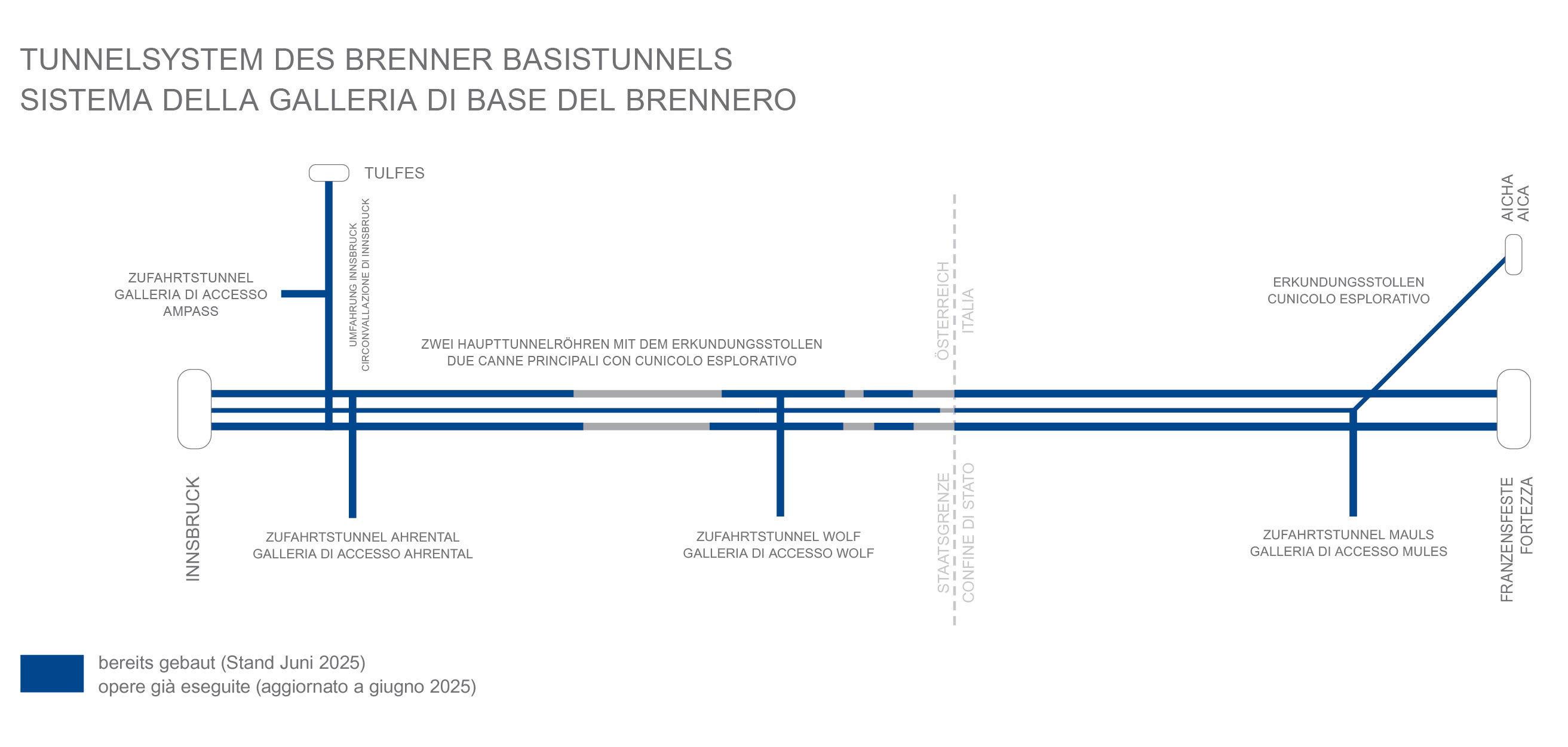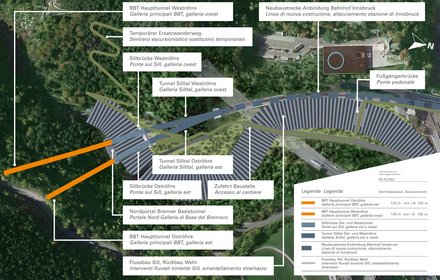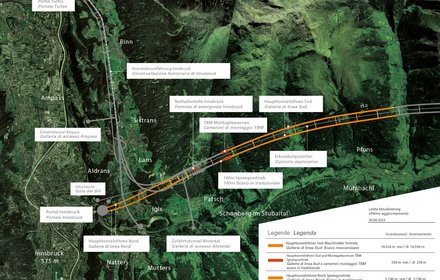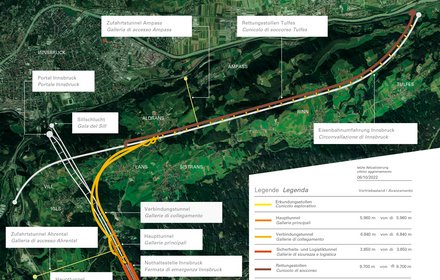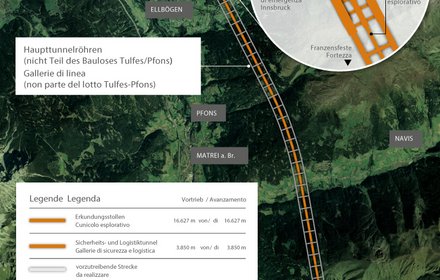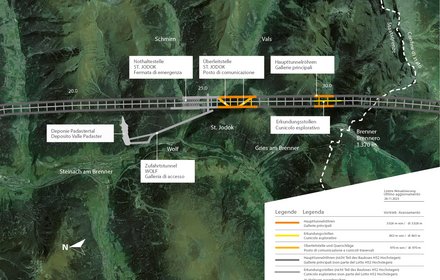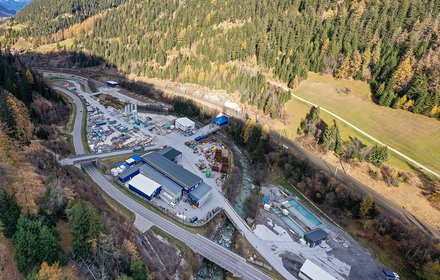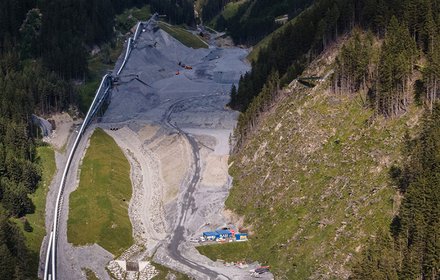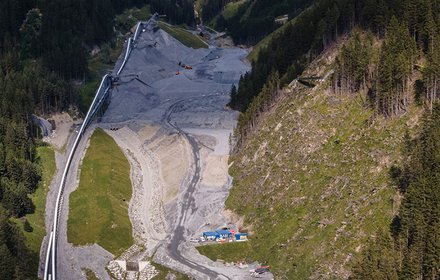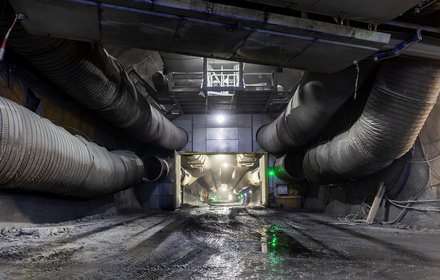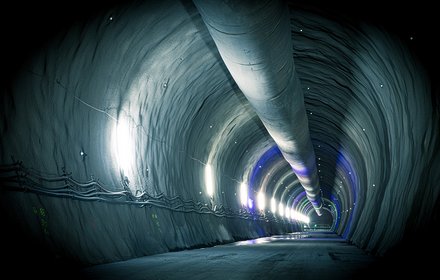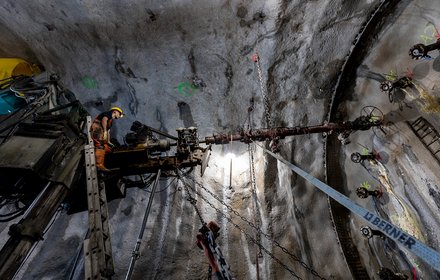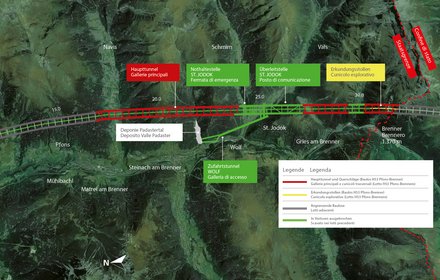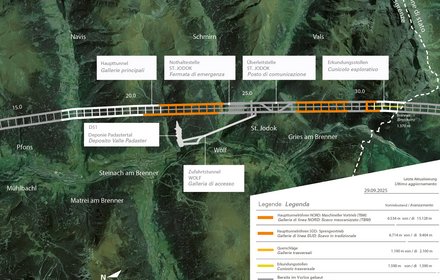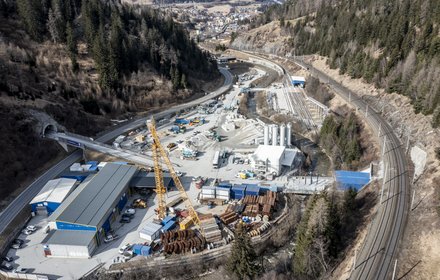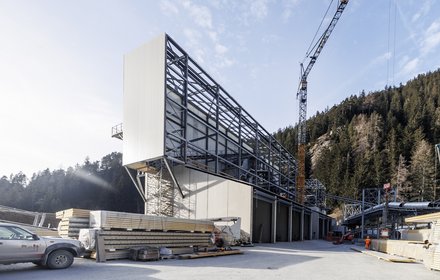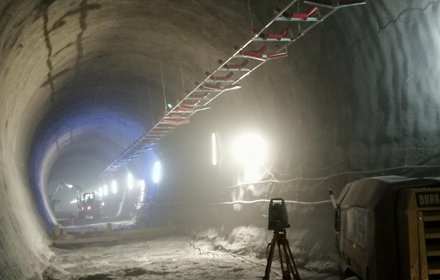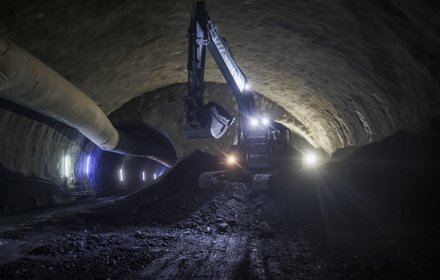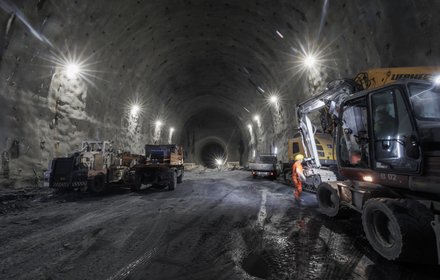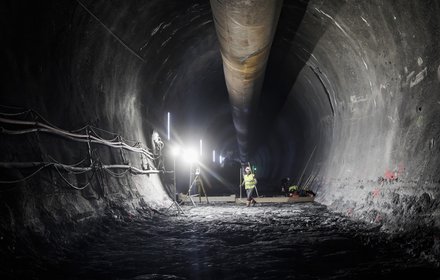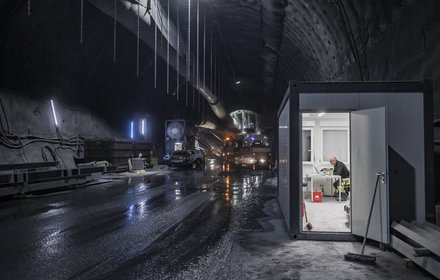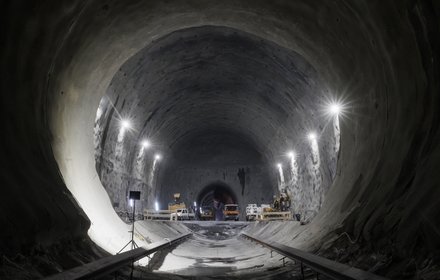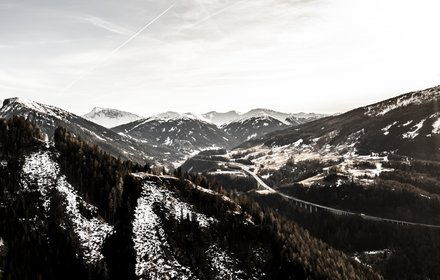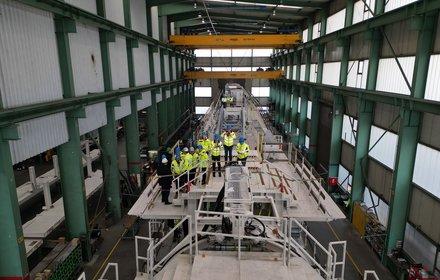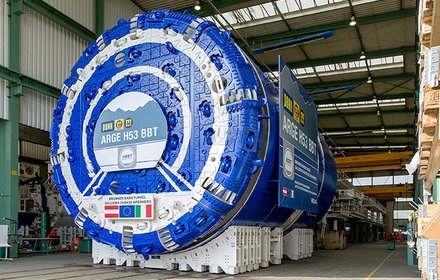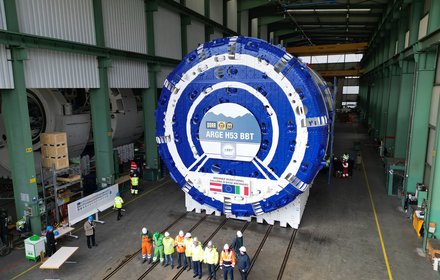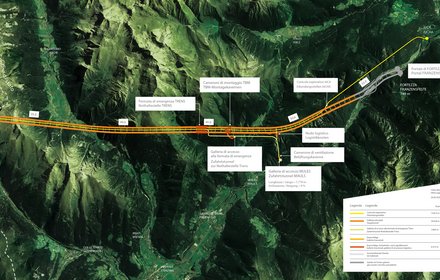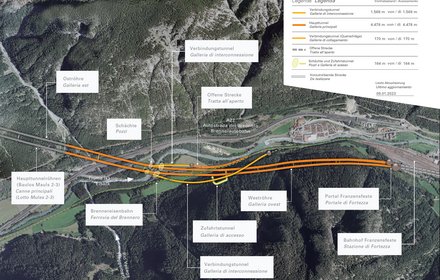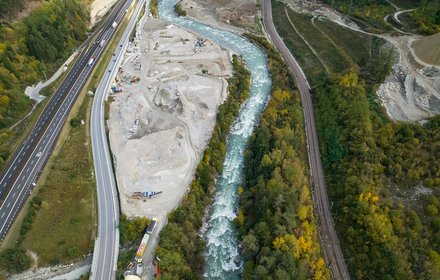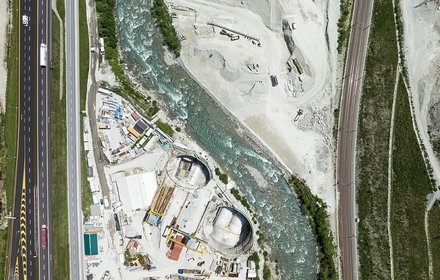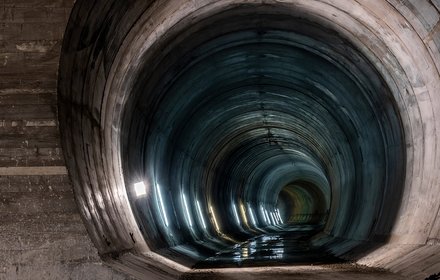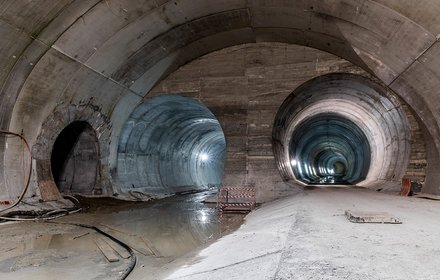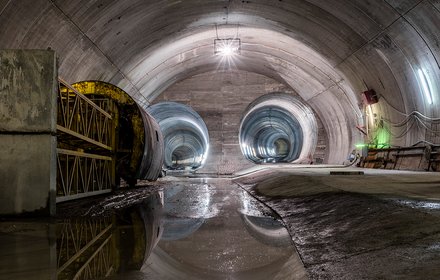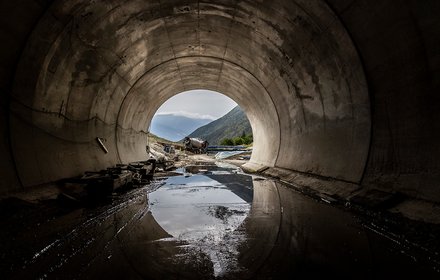Three construction sites are currently in operation, two in Austria and one in Italy. If you simply click on a construction lot, it will take you directly to its brief description, the overview plan and the photo gallery.
The excavation progress of the individual tunnel structures in the various construction lots is updated regularly. Work progress is shown on a graph.
Lot H21 Sill Gorge
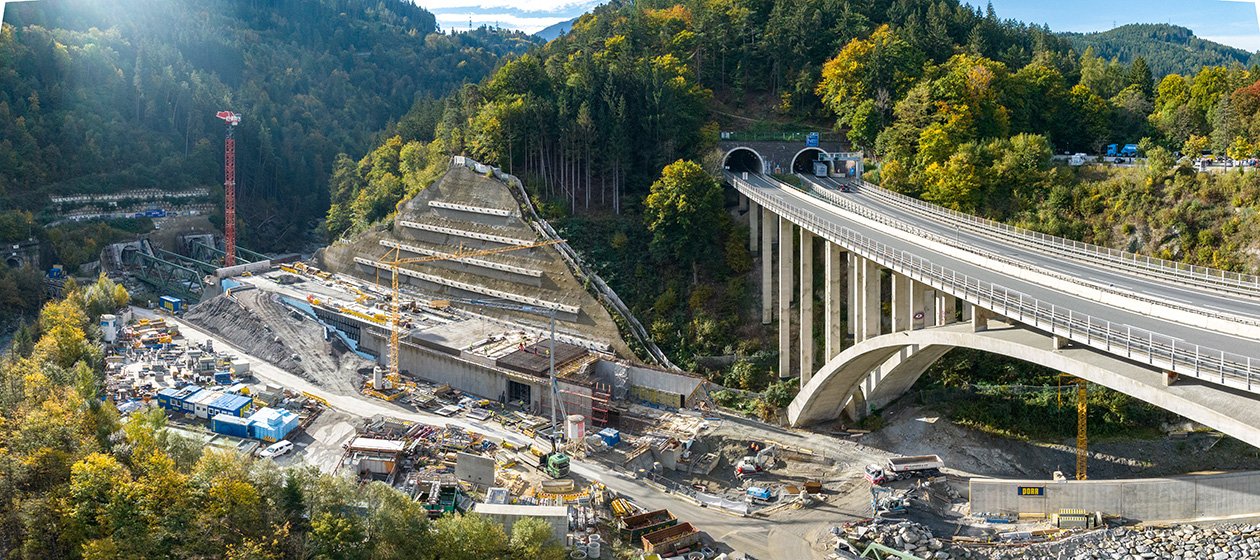
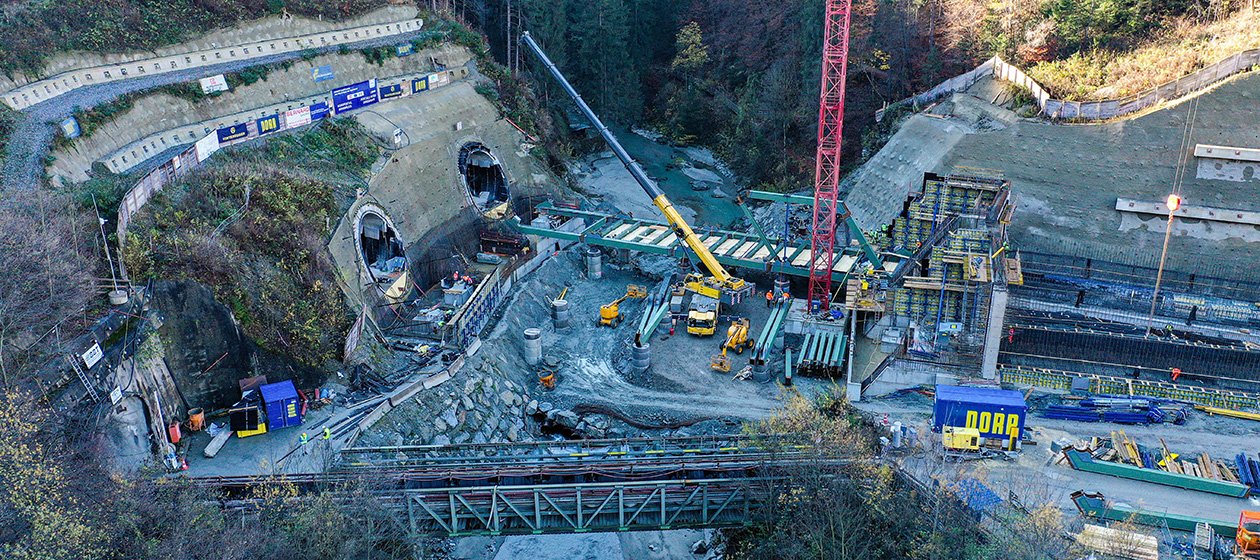
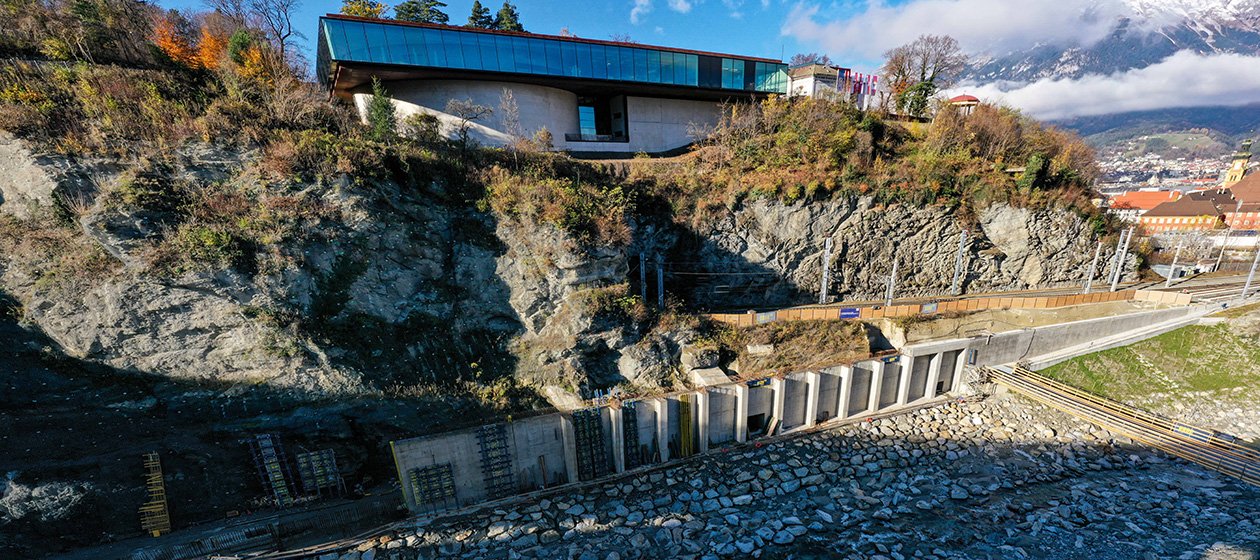
GENERAL INFORMATION ON THE CONSTRUCTION LOT
The works on the H21 construction lot "Sill Gorge" from August 2020 until December 2024 connected the northern end of the Brenner Base Tunnel and the central station in Innsbruck. The Sill Gorge is located to the south of Innsbruck. It is a very popular recreation area and is adjacent to the well-known Bergisel ski jump. In this construction lot, in which the north portal of the Brenner Base Tunnel is located, a section of approx. 600 m was built, including bridges and a (pre-)tunnel, river engineering works, road construction and renaturation works that were carried out after completion of the construction lot. The estimated construction costs for this stretch are 59.5 million Euro and Porr Bau GmbH Kematen was in charge of the works.
Compared to the other construction sites in the Austrian project area, where works take place mostly underground, this is a construction area where most of the work was carried out above ground. For this reason and due to the proximity to the city of Innsbruck, work was "only" carried out during the day. The "Sill Gorge" section mainly included the following construction works: a supporting wall (290 metres long), a cut-and-cover tunnel at the foot of the Bergisel (130 metres long), two steel trellis bridges over the Sill river, the northern portal to the Brenner Base Tunnel and a subsequent 130-metre long stretch of tunnel into the adjacent solid rock (Viller Berg tunnel).
The tunnel breakthrough here will link to the adjacent construction lot H41, located to the south.
In addition, river engineering measures had to be carried out to ensure flood protection and allow fish to pass through. Renaturalisation and path construction work was carried out in order to reintegrate the Sillschlucht recreational area into the existing hiking trail network and thus make it available to the public again. Despite the relatively short stretch to be built, this construction lot comprised very complex construction measures. The route section leads through the narrow and therefore structurally challenging Sill Gorge. This is characterised by a large number of infrastructure facilities in the immediate vicinity, such as the A12 Inntal motorway, the A13 Brenner motorway with the famous arched bridge, the "Untere Sill" power station operated by Innsbrucker Kommunalbetriebe, the "Tirol Panorama" museum (Bergisel) and the existing ÖBB railway line with the Bergisel tunnel.
The gorge, which has been left in its natural state for long stretches, is an important recreational area for the people of Innsbruck and is accessible via hiking trails. In order to keep access to the Sill Gorge open to the public during the construction period, a special replacement hiking trail was built. In addition, a signposting system was installed for better orientation and information boards were erected at the access points near the construction site.
At the construction site itself, the new 42-metre-long road access bridge over the Sill was built. The demolition of the old access bridge and all the river engineering works were completed in spring 2022. With the dismantling of the AGA weir, fish can once again pass upstream on the Sill.
At the end of October 2021, the symbolic groundbreaking for the main southbound tunnels took place. Shortly afterwards, blasting began at the future north portal of the Brenner Base Tunnel. Starting in May 2022, the two main tunnel sections of the Viller Berg, which are around 130 metres long, were excavated into the adjacent solid rock. if you write "have been" it means you're still excavating, but the works are finished
On 17 September 2024, the breakthrough from the south of the east tunnel of construction lot H41 "Sillschlucht-Pfons" was achieved.
In April 2024, the concreting and backfilling work on the retaining wall on the orographic left side of the river was completed. The future tracks that will connect the Brenner Base Tunnel with the Innsbruck railway station at ground level run here.
The concreting work for the Silltal tunnel was completed at the end of 2023. The tunnel was then backfilled with previously removed material and planted with local, native shrubs in the summer. In addition, most of the hiking trails have already been laid out so that the Sill Gorge will be easily accessible to the public once the construction work is complete.
In summer 2024, the final work on the two railway bridges over the Sill was completed, such as the steel structures, the fire protection enclosure and the floor slabs for the railway tracks.
In addition, a 55-metre-long prestressed concrete pedestrian bridge was built over the Sill at the end of 2022, which will form part of the hiking trail network in the Sill Gorge in future.
Completed construction work
• The portal of the "Viller Berg"- tunnel, which is the north portal of the Brenner base tunnel. Here, the BBT runs southwards to Fortezza for 55 kilometres completely in the depths of the mountain. The final work on the portal structure, such as concreting the side edges, was completed in spring.
• The two tunnel tubes, each approx. 130 m long, of the"Viller Berg" tunnel stretch into the adjacent bedrock, integrating and permanently securing the portal structure within the slope.
• Slope stabilisation work for the Silltal tunnel and the Viller Berg tunnel
• The "Silltal Tunnel" through the eastern slope of the Bergisel is approximately 130 metres long and built as a cut-and-cover concrete box, including the northern and southern portals. After the completion of the concrete works, the tunnel was covered with landfill by August and re-planted in order to restore the original natural condition of the area.
• Two railway bridges over the Sill, one for the east and one for the west track. Both bridges were built as open steel trellis bridges. A closed reinforced concrete superstructure was also built for the railway bridge on the west track to prevent ventilation issues in the event of a fire.
• A reinforced concrete retaining wall along the Sill, around 200 m long and over 9 m high, with its foundation on bored pilings. This is where the railway line will run above ground between Innsbruck main station and the north portal of the BBT. After the retaining wall was backfilled with local excavated material, a drainage channel for the future railway tracks, the connection at the northern end of the construction lot to the urban area and railing installations were built.
• Emergency reservoir and cable collector. Two structures which will guarantee proper rail operations. The cable collector supplies the electrical systems of the tunnel. Any liquids escaping in case of an accident are collected in the emergency reservoir and from there they can be properly disposed of.
• A new road access bridge into the Sill gorge
• Pedestrian bridge over the Sill connecting hiking trails fro
m the urban area to the local recreation area in the Sill Gorge.
• 350 m of river engineering works ensure that the course of the Sill is as natural and ecological as possible.
• The former AGA weir was removed in 2021 and replaced by a fish-passable riverbed.
• Construction of hiking trails to the existing trail network in the Sill gorge. In addition, a viewing platform is being built above the Silltal tunnel, providing a view of the Sill gorge and the north portal of the Brenner Base Tunnel.
• Concreting of sidewalks and cable conduits for future railway operations.
• Carrying out final and assembly work, such as installing railings on structures and footpaths so that construction is completed as planned by the end of 2024.
• Construction of connections to the existing network of paths in the Sill gorge. In addition, a viewing platform was built on the Silltal tunnel to allow visitors to view the Sill Gorge and the north portal of the Brenner Base Tunnel.
• Concreting of verges and cable conduits for subsequent railway operation.
• Finishing and assembly work such as installing railings on structures and footpaths.
Ecological aspects in H21
An important part of the construction lot is the restoration of upstream fish passage in the Sill. The AGA weir, located at the entrance to the Sill gorge with a drop height of approx. 8 metres, was removed in 2021 and replaced by a roughly 350-m long fish ladder with a low-lying meandering channel in which water runs even during the dry season. In the course of these river engineering works, the riverbed was moved about 8 metres to the east in order to gain sufficient space on the western side for the retaining wall with the new double-track line running on it. Flood-proof and long-lasting, stable embankments were constructed and re-naturalised.
Appropriate renaturalisation and restoration of the original landscape will take place, for example by backfilling the Silltal tunnel at the end of construction, including planting with typical native trees and shrubs, thus restoring the original natural condition of the Sill gorge.
EXCAVATION DATA - All the excavation works in this lot were completed by May 2022
| Main tunnel East (completed) | ||
|---|---|---|
| Excavation 120 m | Length 120 m | Cross-section 100 m² |
| Main tunnel West (completed) | ||
|---|---|---|
| Excavation 130 m | Length 130 m | Cross-section 100 m² |
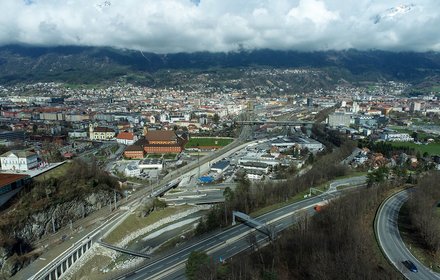
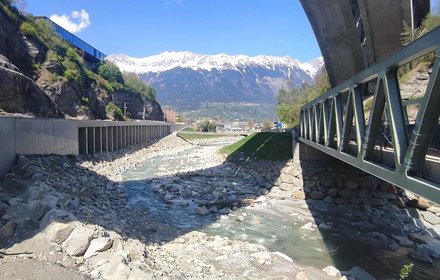
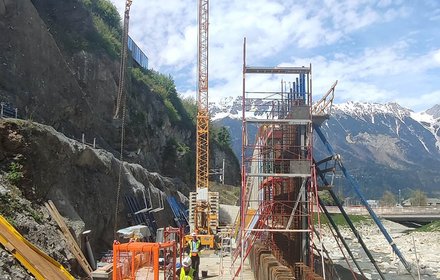
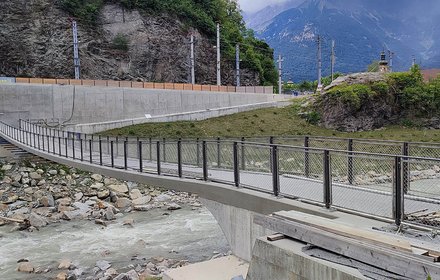
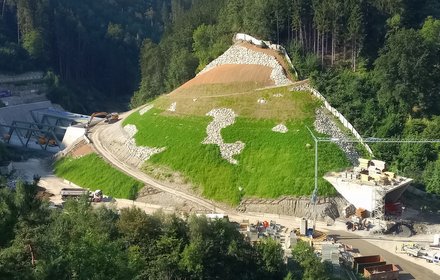
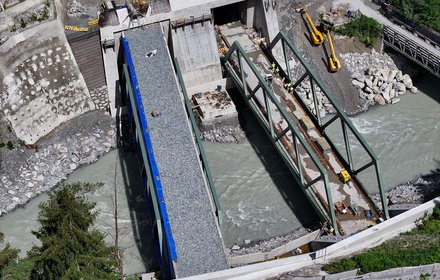
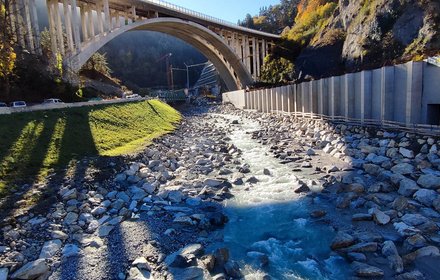
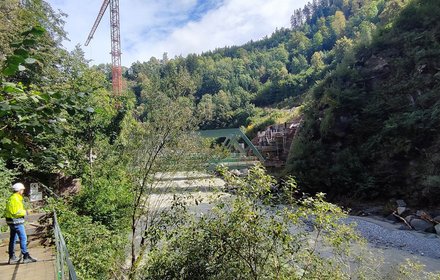
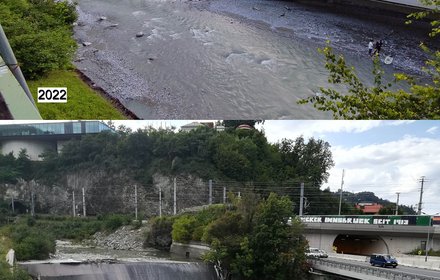
Lot H41 Sill Gorge-Pfons
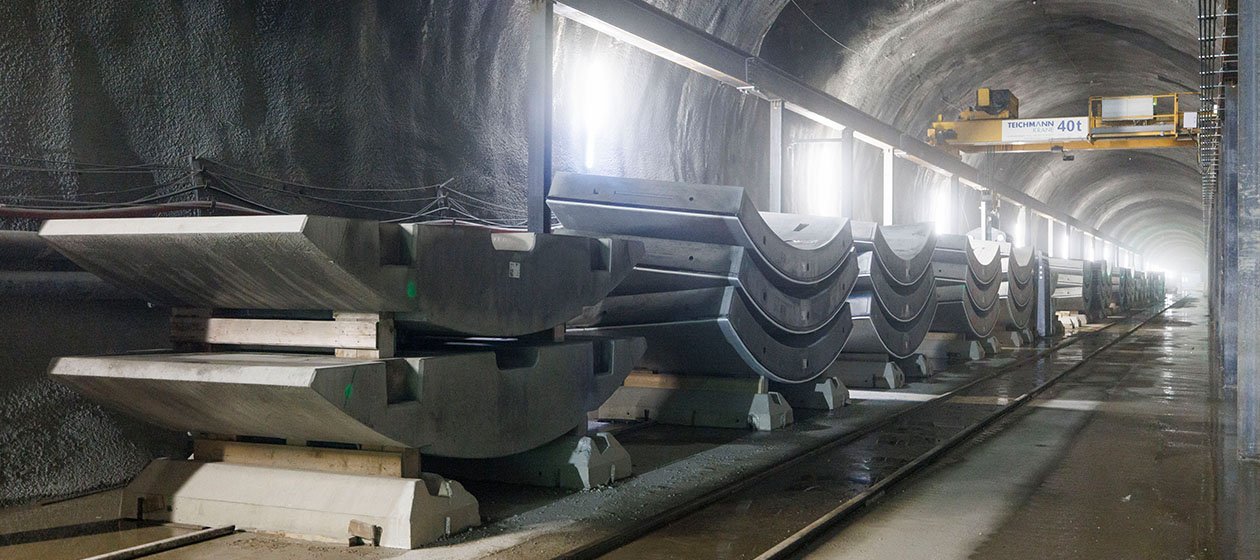
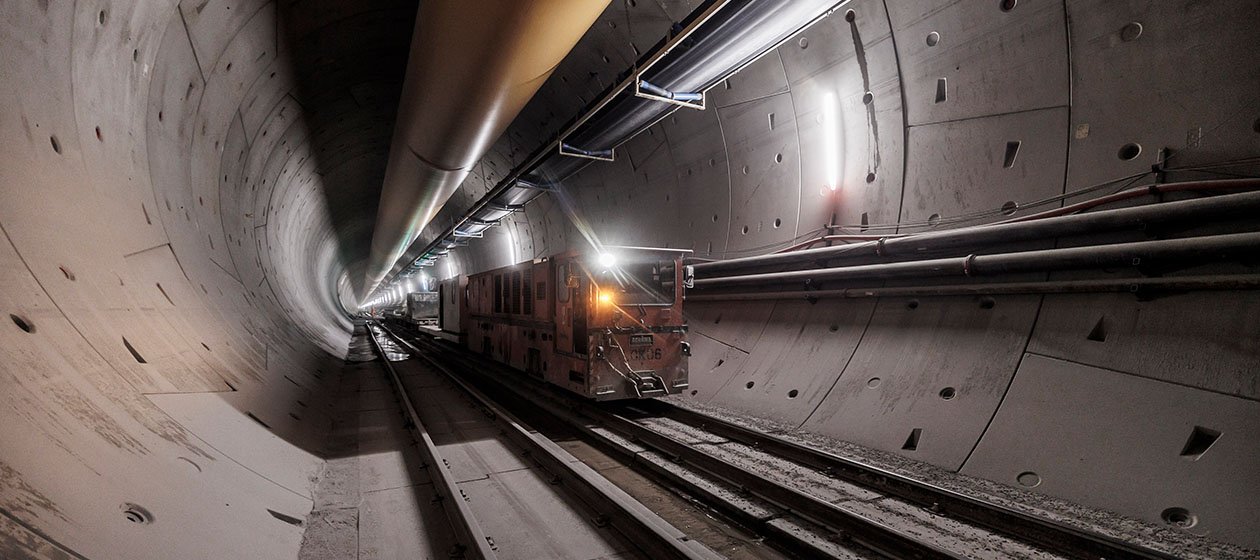
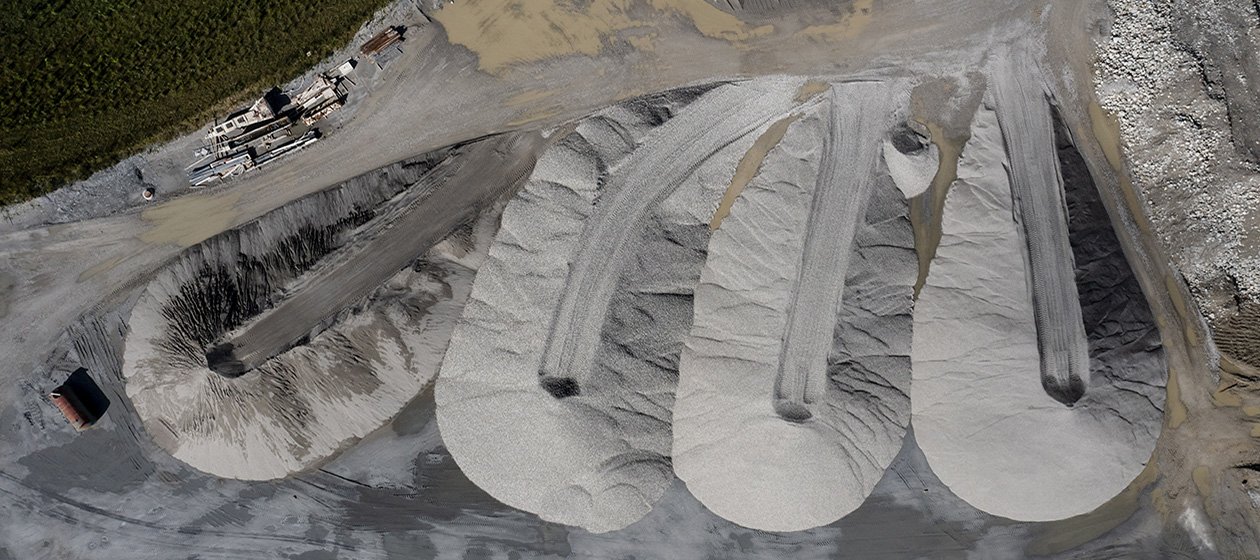
GENERAL INFORMATION ON THE CONSTRUCTION LOT
Works on this construction lot began in mid-January 2022 with the set-up of the construction site. Excavation works started in July 2022 towards Innsbruck with the lowering of the cross-chamber slab.
The H41 "Sill Gorge-Pfons" construction lot is located in the northern area of the BBT between the Sill Gorge of Innsbruck in the north and Pfons in the south. The Ahrental access tunnel, which has already been completed in the E41 "Ahrental" prospection lot, is used for the main excavation.
This construction lot represents the continuation of the construction works carried out in the H33 "Tulfes-Pfons" preliminary lot. The tender for the H41 construction lot was awarded on 17/11/2021 to the bidding consortium H41 Sill Gorge-Pfons comprising the companies Implenia Österreich GmbH, Implenia Schweiz AG, Webuild S.p.A, csc costruzioni sa. The total bid amount offered by the bidding consortium is 651 million euro.
In total, approx. 22.5 km of main tunnel tubes and 38 cross passages with a total length of approx. 2.3 km will be excavated by the summer of 2028 in this construction lot. In order to ensure the fastest progress possible in the whole project, the "Sill Gorge-Pfons" project area was extended southwards by three kilometres of main tunnel tubes, where it will connect to the construction lot H53 "Pfons-Brenner".
The works basically include the following:
- Remaining excavation of the Innsbruck emergency stop including excavation by blasting of the western mail tunnel tube up to the western assembly chamber for the TBM and to the eastern assembly chamber for the TBM
- Blasting of main tunnel tubes northwards from Ahrental to the location of the breakthrough in the H21 "Sill Gorge" construction lot (east tube approx. 2,331 m long, west tube approx. 3,415 m long)
- Mechanical excavation of the main tunnel tubes southwards from Ahrental up to the border of the construction lot H53 "Pfons-Brenner" (east tube approx. 8,108 m long, west tube approx. 8,396 m long)
- Inner lining operations in both main tunnel tubes, each approx. 14.4 km long, as well as in the Innsbruck emergency stop, the Ahrental cross-chamber, the cross passages (every 333 m), in the exploratory tunnel, in the Ahrental access tunnel including the Ahrental ventilation chamber and in the Patsch shaft as well as in the Sill Gorge access tunnel
- Partition wall for the Innsbruck connecting tunnel east and west and tracks in side corridors (safety corridor) for the Innsbruck connecting tunnel east and west
- Long-distance flushing system in the connecting tunnels Innsbruck east and west
- Construction of a 69.4 metre long bridge over the A13 Brenner motorway
The following optional work was also tendered:
- Remaining concrete inner lining in the Tulfes emergency tunnel
Current construction work:
- Excavation main tunnel east southwards with TBM Lilia
Completed construction work:
- Construction of conveyor belt systems from underground to the Ahrental disposal site
- Blasting assembly chamber west
- Blasting assembly chamber east
- Reinforcement works in the expolatory tunnel
- Excavation emergency stop
- Building of a production hall for the manufacture of tubbing rings (pre-cast concrete elements for the inner lining)
- Construction of conveyor belt systems from underground to the Padastertal disposal site
- Bridge over the A13 Brenner motorway
- Erection of partition walls for the Innsbruck connecting tunnel east and west and tracks in side corridors (safety corridor)
- Installation of the long-distance flushing system in the connecting tunnels Innsbruck east and west
- Excavation main tunnel east northwards (Innsbruck)
- Excavation main tunnel west northwards (Innsbruck)
- Excavation main tunnel west southwards with TBM Ida
EXCAVATION DATA of September, 30th 2025 (Updated monthly)
| Main tunnel tubes SOUTH: TBM excavation | ||
|---|---|---|
| Excavation 16,524 m | Length 16,594 m | Cross-section 85 m² |
| Mail tunnel tubes SOUTH and assembly rooms TBM: drill and blast (completed) | ||
|---|---|---|
| Excavation 258 m | Length 258 m | Cross-section 82-210 m² |
| Mail tunnel tubes NORTH: drill and blast (completed) | ||
|---|---|---|
| Excavation 5,746 m | Length 5,746 m | Cross-section 70 m² |
| Crosscuts | ||
|---|---|---|
| Excavation 2,120 m | Length 2,260 m | Cross-section 30-70 m² |
| Emergency stop Innsbruck, remaining excavation (completed) | ||
|---|---|---|
| Excavation 702 m | Length 702 m | Cross-section 15-100 m² |
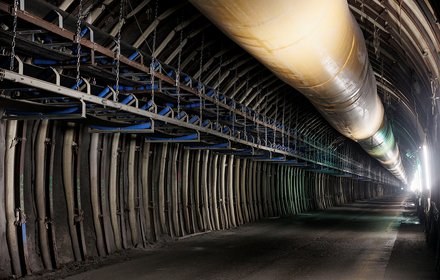
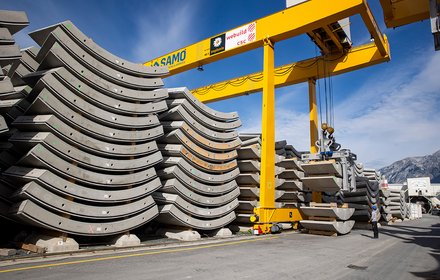
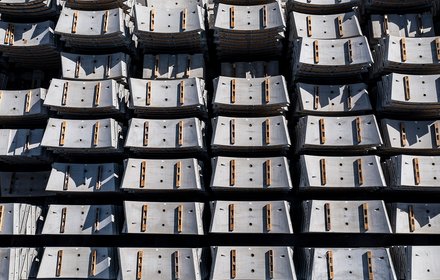
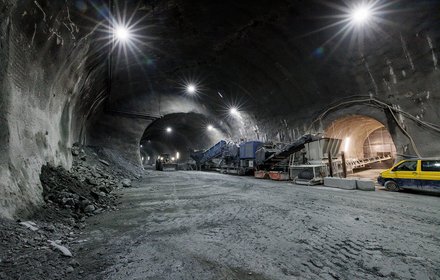
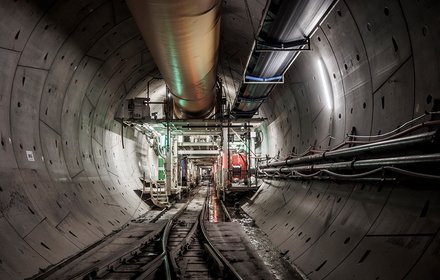
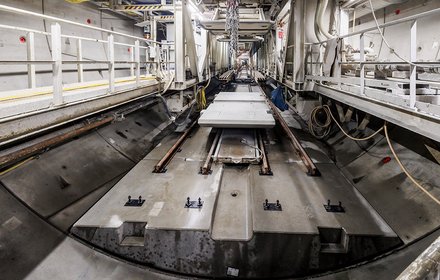
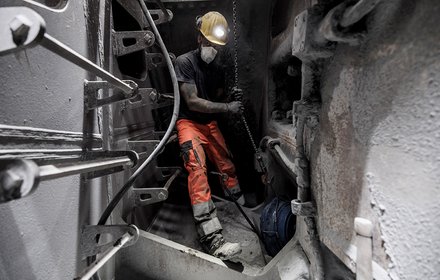
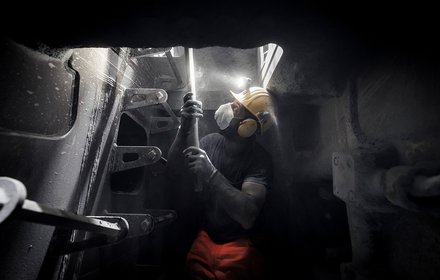
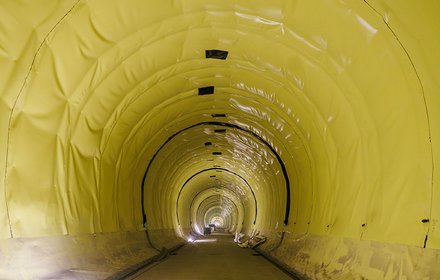
Lot H33 Tulfes-Pfons
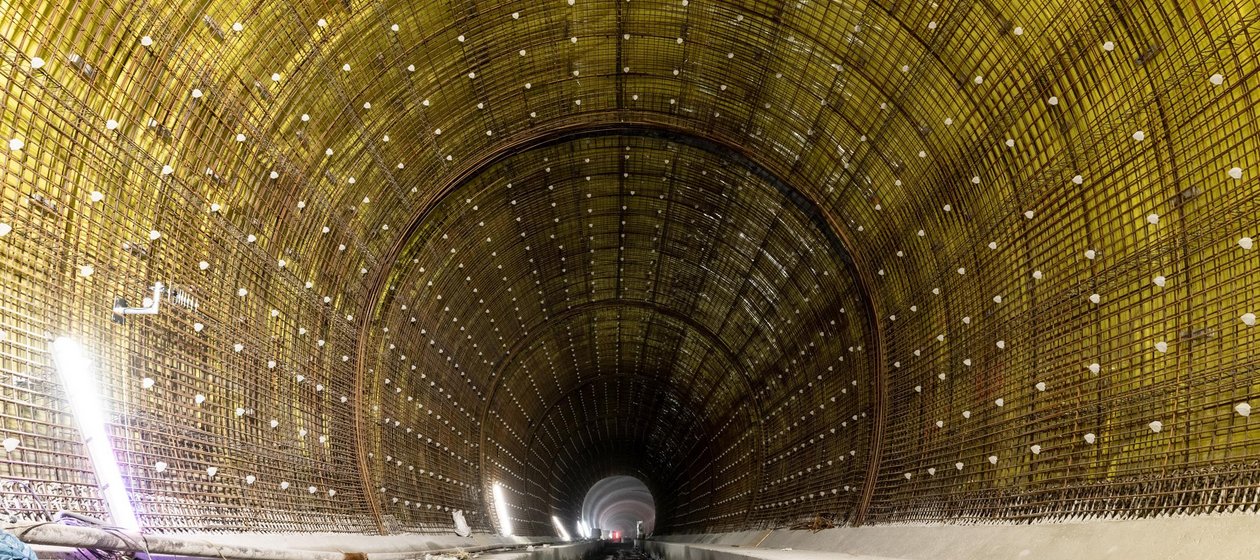
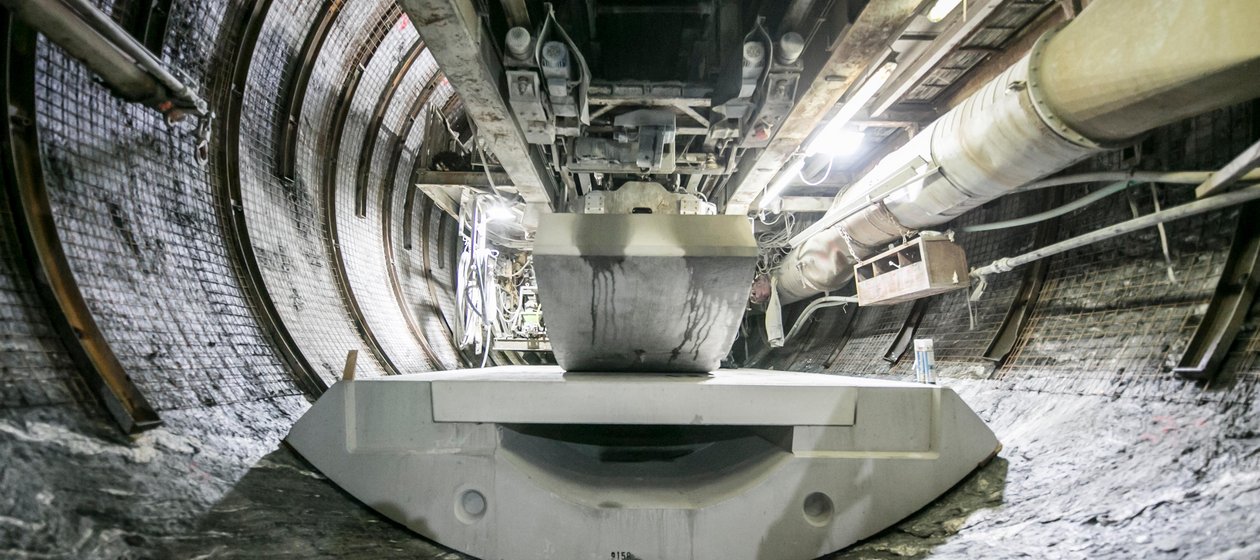
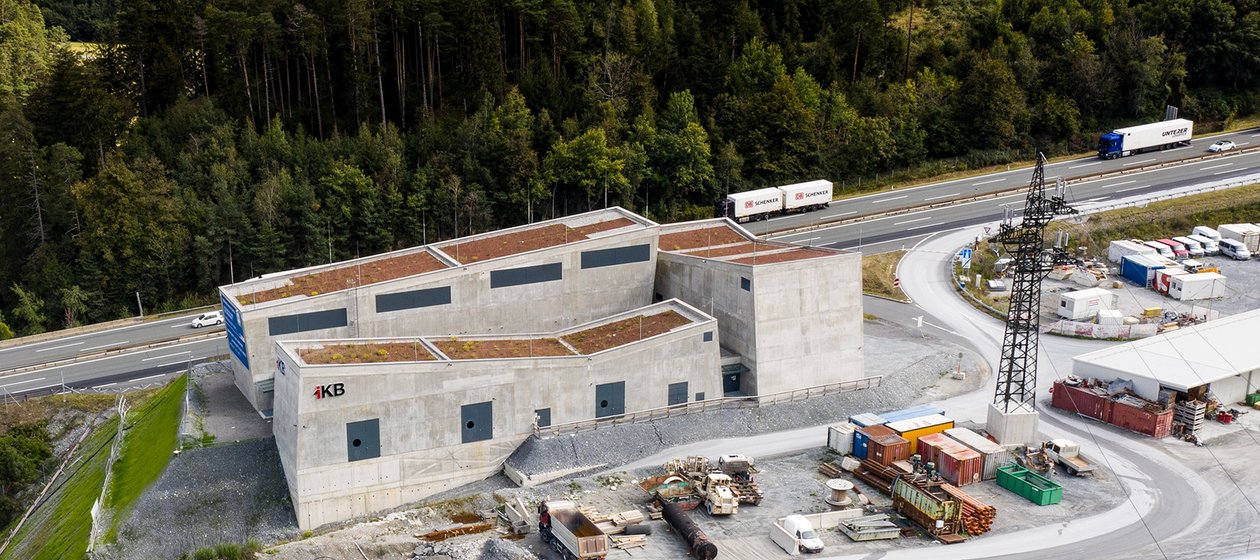
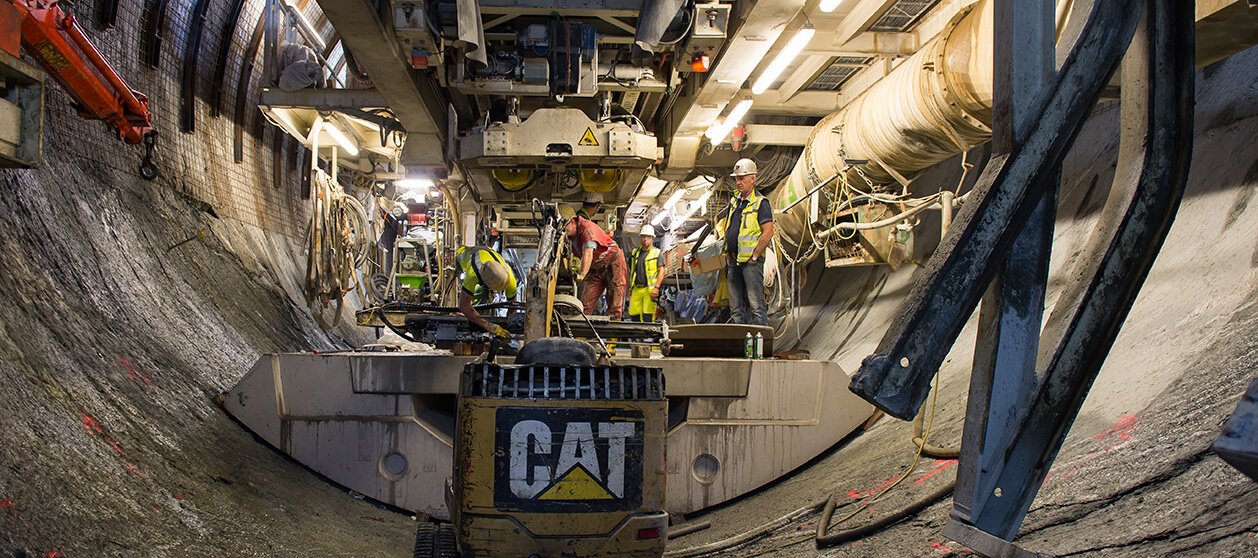
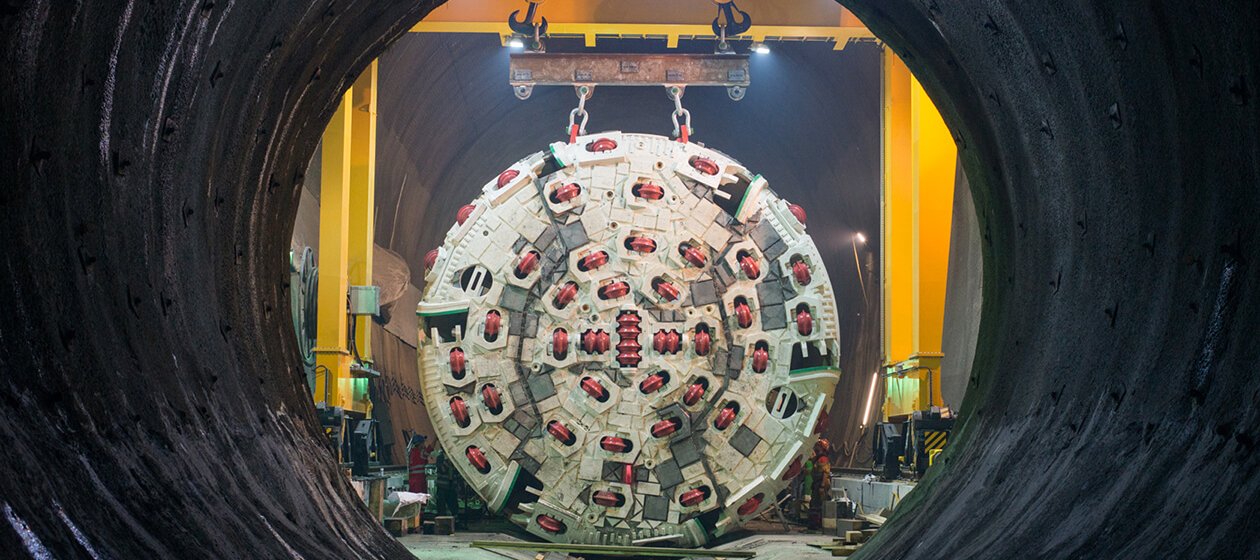
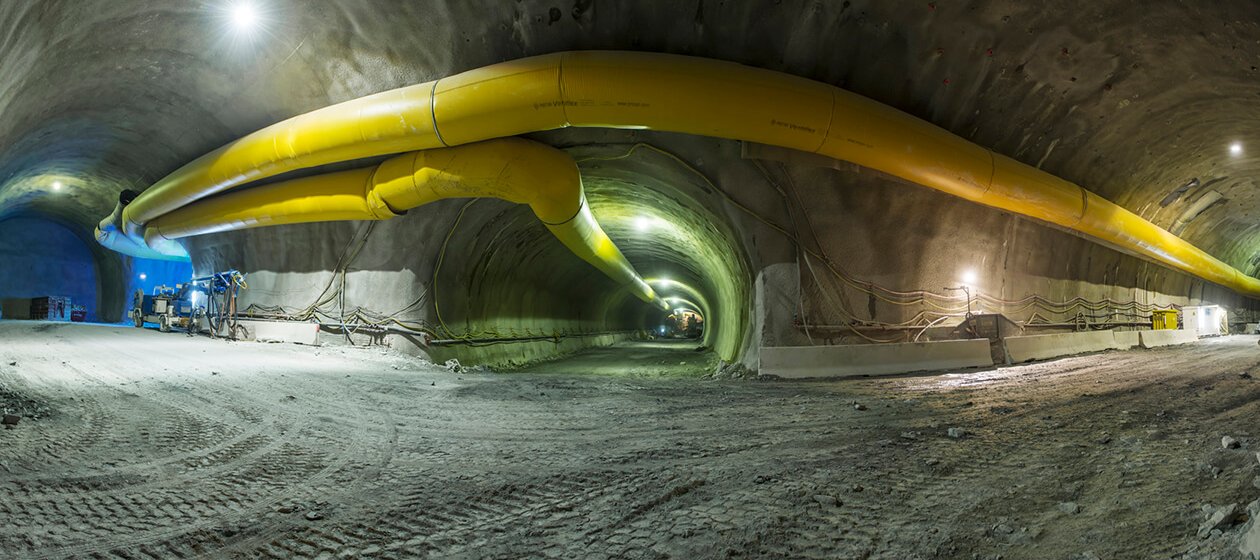
GENERAL INFORMATION ON THE CONSTRUCTION LOT
Since the end of September 2021, all work in this construction lot has been completed.
This construction lot was awarded to the Strabag SE / Webuild S.p.A. (ex Salini-Impregilo) bidding consortium in Summer of 2014.
construction time: 2014 - 2021
section of the tunnel to be driven: 43.3 km
awarded for: € 377 million
It consists of several structures:
- Tulfes emergency tunnel
- Innsbruck emergency stop
- Main tunnel tubes
- Connecting tunnels
- Ahrental-Pfons exploratory tunnel
Construction works
Emergency tunnel
The emergency tunnel was being driven parallel to the existing Innsbruck railway bypass. It is 9.7 km long and the excavation cross-section is 35 m². The drill-and-blast excavation work on this tunnel started from three points at the same time: from Tulfes westwards, from the Ampass access tunnel eastwards and again westwards. The emergency tunnel was completed in Summer of 2017.
Main tunnel tubes
The main tubes have been excavated by blasting according to the so-called New Austrian Tunnel Construction Method. The ceremonial first volley was set off on 19/03/2015 in the presence of EU Commissar Violeta Bulc and the Ministers of Transportation of the 7 Alpine countries (Austria, Italy, Germany, Switzerland, France, Liechtenstein and Slovenia. This stretch includes about 6 km of main tunnels with an excavated cross-section of about 70 m2 .
Connecting tunnel between the BBT and the Innsbruck bypass
Construction has been under way since summer of 2015 on the two connecting tunnels between the Brenner Base Tunnel and the existing Innsbruck bypass. The connecting tunnels were also excavated by blasting, with a cross-section of about 115 m². Excavation work was completed in Spring of 2017.
Exploratory Tunnel
The construction lot Tulfes-Pfons included the construction of the stretch of exploratory tunnel between the Ahrental junction point and the town of Steinach am Brenner. The gripper TBM, 200 m long, started work on September 26th, 2015 and excavated about 16.7 km southwards, completing its work on July 6th, 2019. Since the breakthrough, the construction lot has been connected to the Pfons-Brenner lot.
Restoration of the collapse "Iris"
This collapse is a cavity that formed in a fault zone during the excavation of the exploratory tunnel. This had to be backfilled by means of cement mortar injections from an injection tunnel in order to rule out any effects on the overall tunnel system. As part of these repair works, the main tunnel tubes in the fault zone were excavated from July 2020 to May 2021 in advance by blasting using an auxiliary drivage from the exploratory tunnel. This allows to reduce interferences when the next TBM arrives.
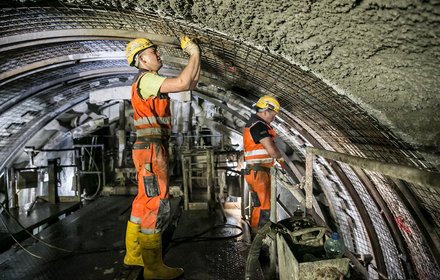
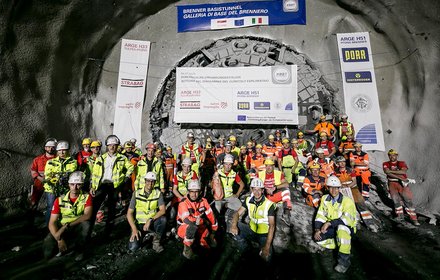
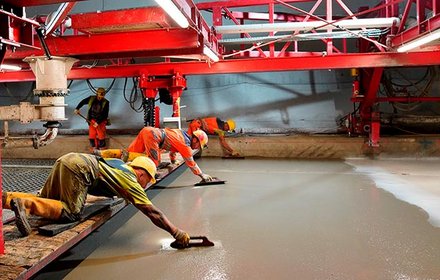
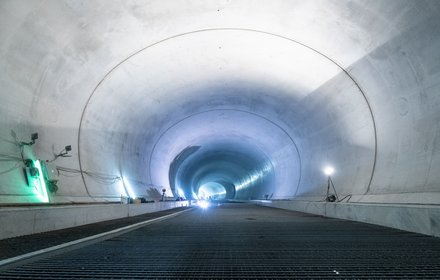
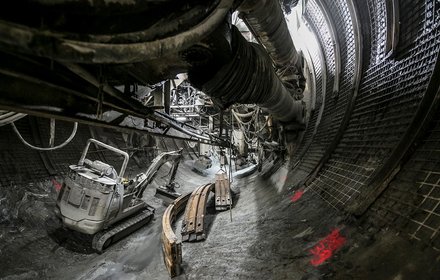
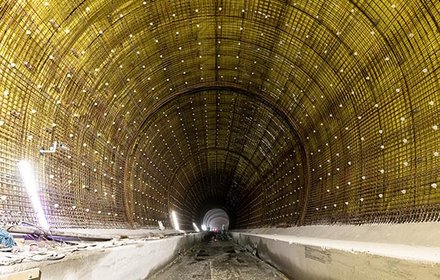
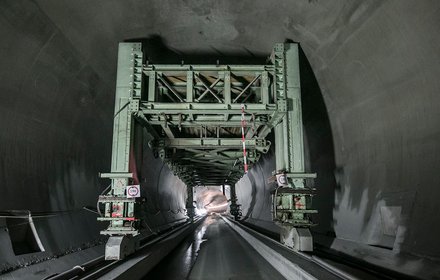
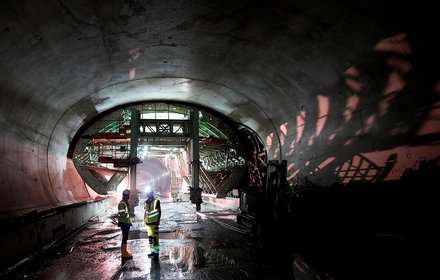
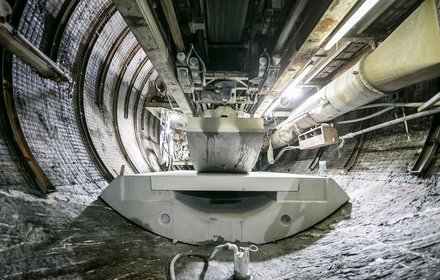
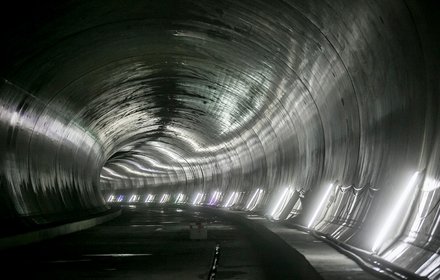
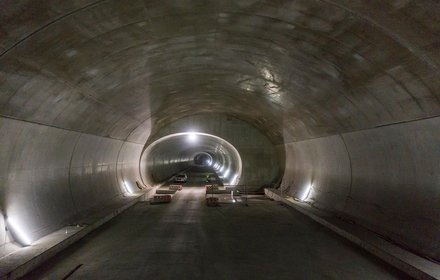
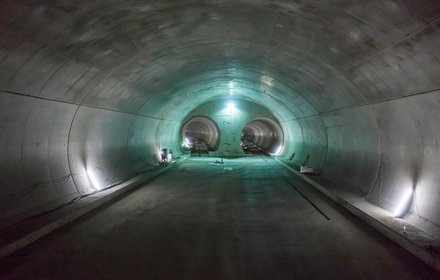
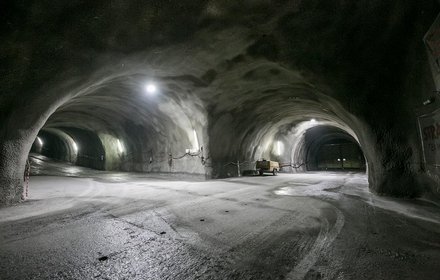
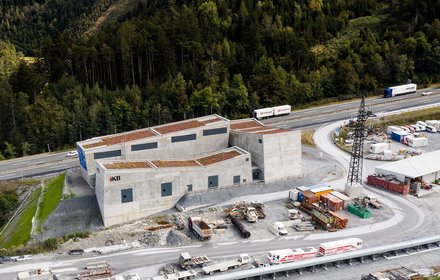
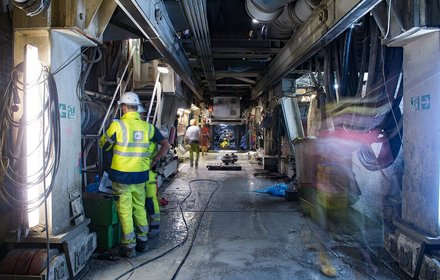
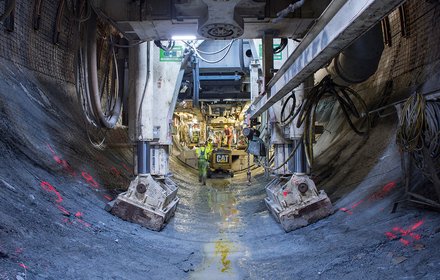
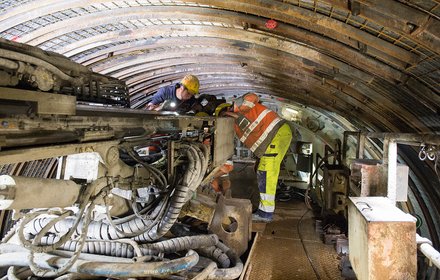
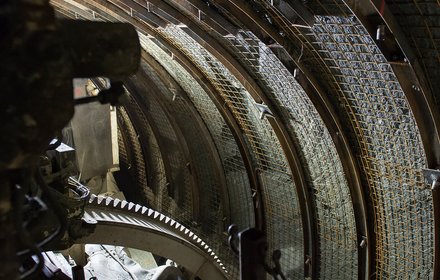
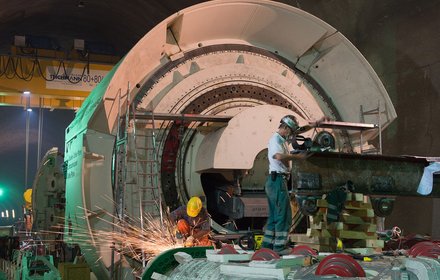
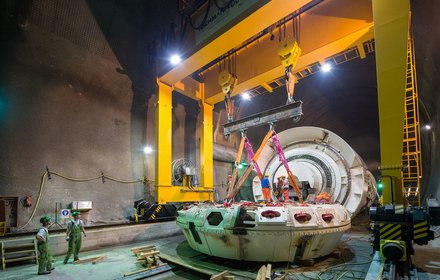
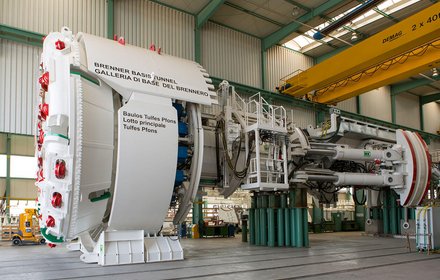
Lot H52 Hochstegen
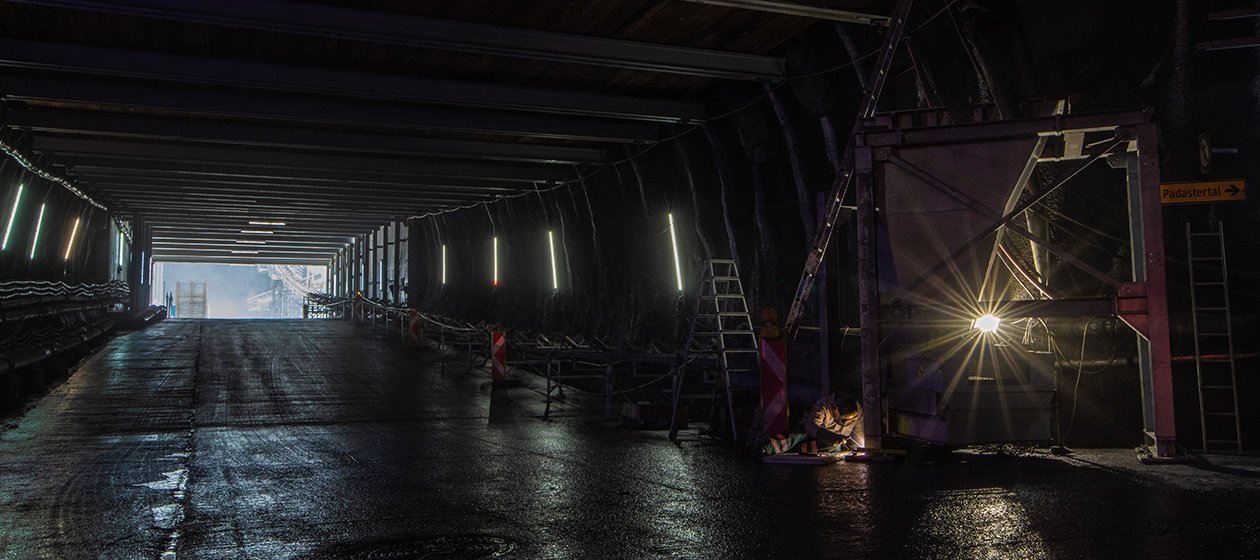
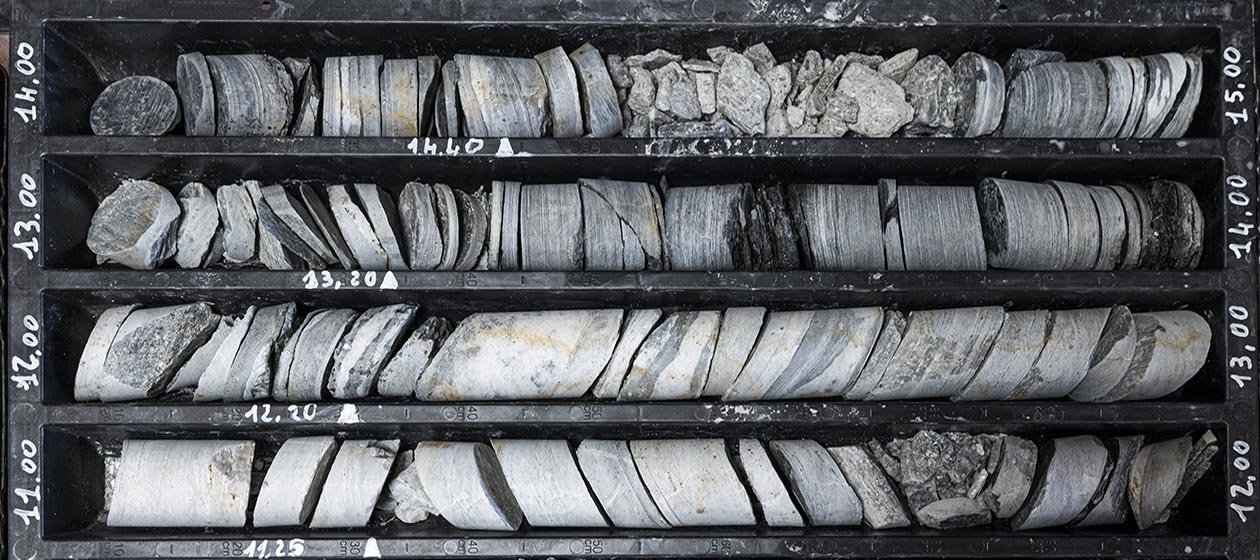
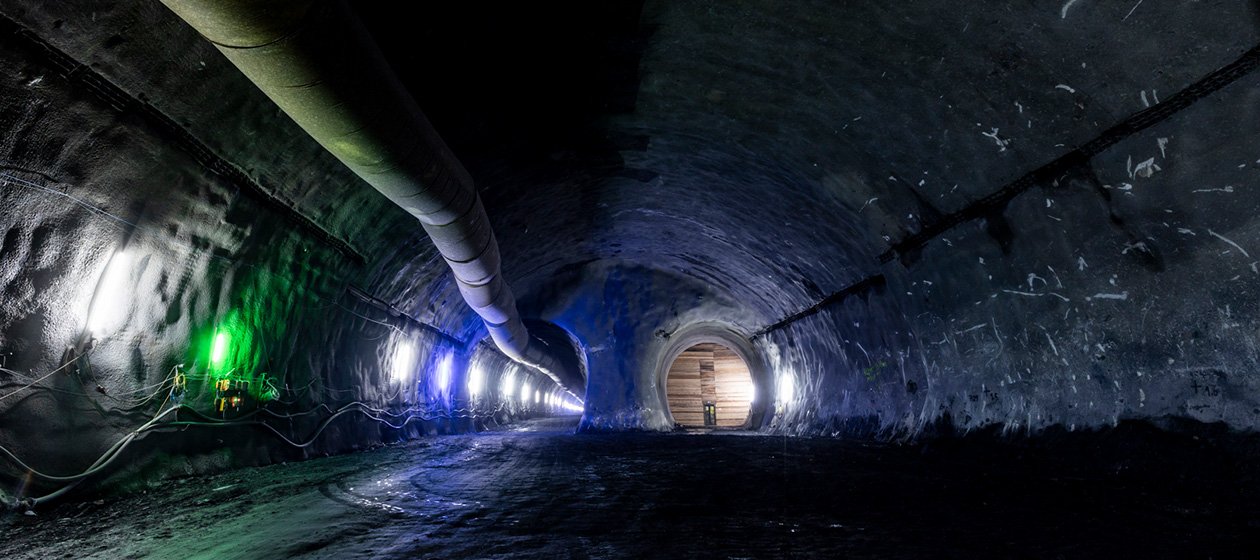
GENERAL INFORMATION ON THE CONSTRUCTION LOT
All work on this construction lot has been completed since December 2023.
Works on this construction lot began in February 2022 with the set-up of the construction site area at Wolf. On 4 May 2022, the ground-breaking ceremony took place in the costruction lot.
The H52 - Hochstegen construction lot, located within the area of the Steinach am Brenner township, is a part of the previous lot H51 - Pfons-Brenner which has now been restructured. This stretch of the project was divided in several construction lots, in order to guarantee the fastest and most efficient continuation of the works with an aim to driving the entire project forward quickly. The Wolf lateral access tunnel is used as a main access and supply route.
The Hochstegen lot is located in a zone characterized by extremely complex geological conditions. The stretch is about 500 m long, with mainly water-bearing, carbonatic rock layers, meaning that the tunnel excavation in this stretch is particularly challenging. The contract for the works in the H52 - Hochstegen construction lot was awarded to Swietelsky Tunnelbau GmbH & Co KG on December 15th, 2021. The bid was around 102 million Euro and construction time is expected to be 23 months.
The core of the project is the excavation of the exploratory tunnel southwards through the geologically challenging stretch known as "Hochstegen", where excavation will take place with the protection of preliminary sealing and stabilisation injections.
The works basically include:
- 0.9 km of exploratory tunnel excavated southwards
- 3.0 km of main tunnel excavated southwards
- 0.6 km of connecting tunnels
- 0.3 km of cross-passages
Completed construction work
- Excavation work in the southern exploratory tunnel and in the main tubes, starting from the auxiliary drivage
- Installation of an approx. 9 km long conveyor belt to the "H41 Sill Gorge-Pfons" construction lot
- Construction of an auxiliary drivage from the exploratory tunnel to the main tunnel tubes in the Hochstegen zone
- Excavation of the northern transition to the Hochstegen marble in the exploratory tunnel and the main tunnel tubes
- Construction of a cross-over point
- Injection measures in the area of the exploratory tunnel in the section of the Hochstegen marble
Hydrogeological construction support and monitoring of water resources:
With rock mass improvement measures in the form of injections, both water inflows and a lowering of the water levels in the protected areas "Hinteres Venntal" and "Hinteres Valsertal-Natura 2000" are to be avoided and the inflow quantities significantly reduced.
EXCAVATION DATA - All the excavation works in this lot were completed by November 2023
| Main tunnel tubes (completed) | ||
|---|---|---|
| Excavation 3,026 m | Length 3,026 m | Cross-section 60-80 m² |
| Exploratory tunnel (completed) | ||
|---|---|---|
| Excavation 863 m | Length 863 m | Cross-section 60 m² |
| Cross-over and connecting side tunnels (completed) | ||
|---|---|---|
| Excavation 970 m | Length 970 m | Cross-section 25-30 m² |
Lot H53 Pfons-Brenner
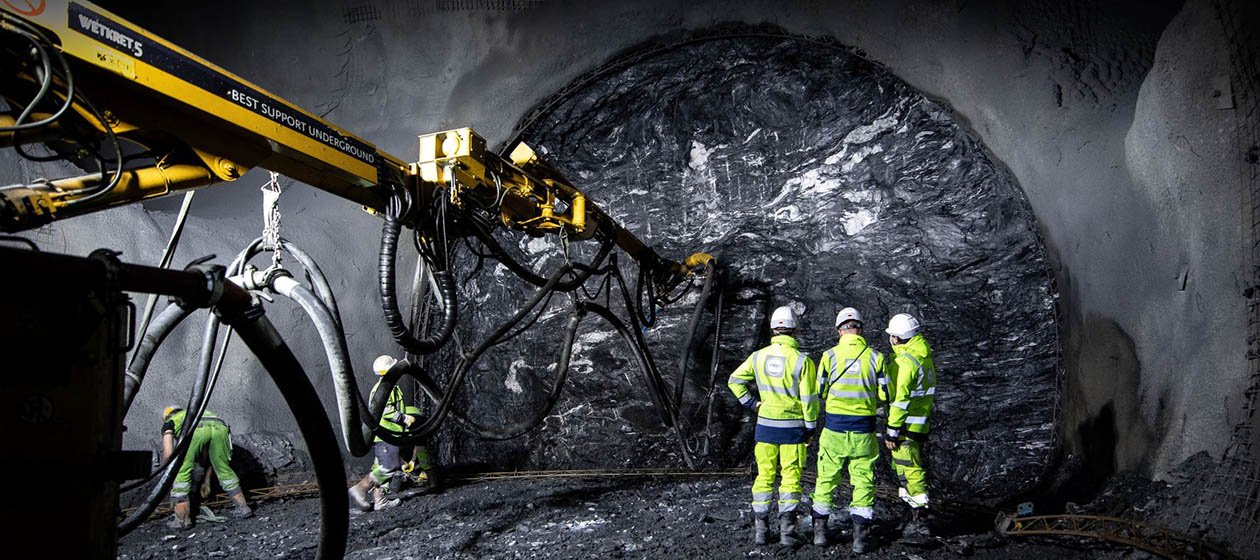
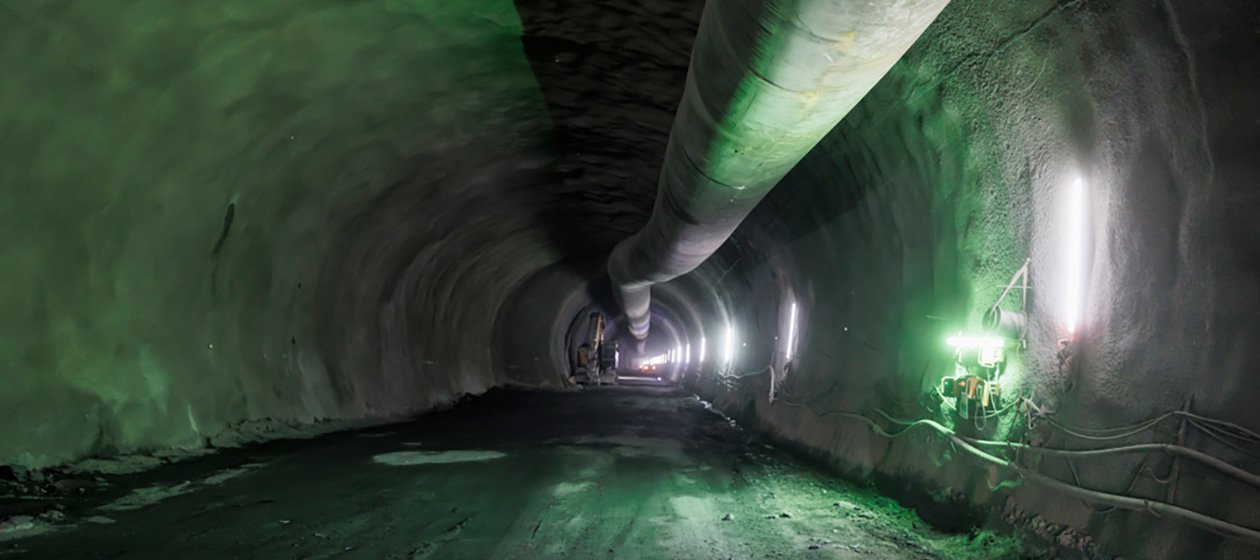
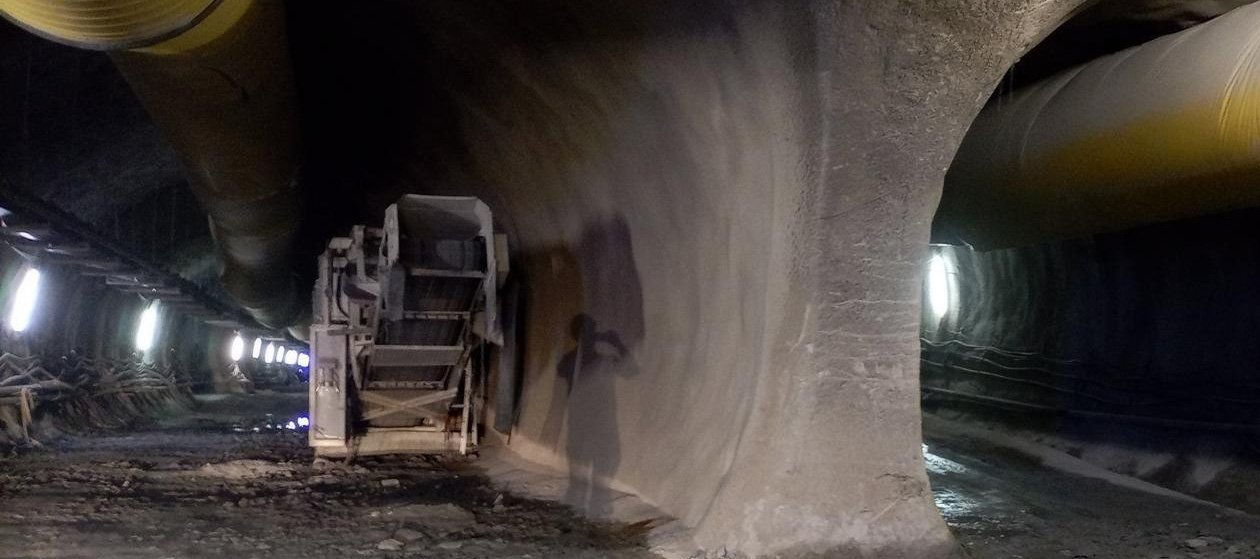
GENERAL INFORMATION ON THE CONSTRUCTION LOT
On April 4, 2023, the contract for the construction lot "H53 Pfons-Brenner" was awarded to a bidder consortium consisting of Porr Bau GmbH, Marti GmbH Austria and Marti Tunnel AG Switzerland.
With this award, the tunnelling works of the last remaining construction lot of the Brenner Base Tunnel have been commissioned. The contract value for what is now the largest construction lot on Austrian project territory amounts to EUR 959 million. The scheduled construction time for this tunnel section is 70.5 months.
Construction work for this lot started on May 4, 2023, and the order was made for the two tunnel boring machines (TBM) for this lot. The two TBMs will drive a stretch of 7.6 km (a total of approx. 15.2 km) in each main tunnel tube. Once ordered, delivered and installed, the two tunnel boring machines Wilma and Olga began excavating northwards on 18 September 2024.
Tunnelling work according to the "NATM" (New Austrian Tunnelling Method, cyclical driving) will start much earlier, moving southwards to the national border at Brenner. Excavation using the New Austrian Tunnelling Method (NATM), a cyclical excavation technique, began much earlier and progressed southwards towards the border at the Brenner Pass. They began in March 2024.
The miners will excavate around 5 km per main tunnel tube (10 km in total) in the southern section of construction lot H53 Pfons-Brenner. At the same time, excavation work will continue in the exploratory tunnel, where the miners have to drive approx. 1.6 km.
Parallel to the respective drives in the north and south of the construction lot, 37 cross-passages of approx. 70 m each, i.e. 2,590 m, are being excavated. After completing the tunnelling work in the respective sections, the inner lining work will be carried out in the entire area from the lot boundary with lot H41 Sill Gorge-Pfons to the state border at Brenner, as well as in the access tunnel in Wolf.
The construction lot includes the following excavation works:
- ca. 15.2 km of main tunnel northwards using a TBM
- ca. 10.0 km of main tunnel southwards using the NATM method
- ca. 1.6 km of exploratory tunnel southwards
- ca. 2.6 km of cross passages (37)
The construction lot includes the following inner lining works:
- ca. 15.6 km of exploratory tunnel
- ca. 15.6 km of main east tunnel
- ca. 15.5 km of main west tunnel
- ca. 3.1 km of cross passages (45)
- ca. 5.1 km of auxiliary structures (Wolf access tunnel, spoil tunnel, etc.)
Current construction work
• Blasting excavation main western southbound tunnel
• Blasting excavation main eastern southbound tunnel
• Blasting excavation exploratory tunnel southwards
• Excavation main tunnel east northwards with TBM Olga
• Excavation main tunnel west northwards with TBM Wilma
EXCAVATION DATA of September, 29th 2025 (Updated monthly)
| Main tunnel tubes NORTH: TBM excavation | ||
|---|---|---|
| Excavation 6,534 m | Length 15,128 m | Cross-section 85 m² |
| Mail tunnel tubes SOUTH: drill and blast | ||
|---|---|---|
| Excavation 6,714 m | Length 9,404 m | Cross-section 80 m² |
| Crosscuts: drill and blast | ||
|---|---|---|
| Excavation 1,190 m | Length 2,100 m | Cross-section 30 m² |
| Exploratory tunnel: drill and blast (completed) | ||
|---|---|---|
| Excavation 1,590 m | Length 1,590 m | Cross-section 60 m² |
Lot H61 Mules 2-3
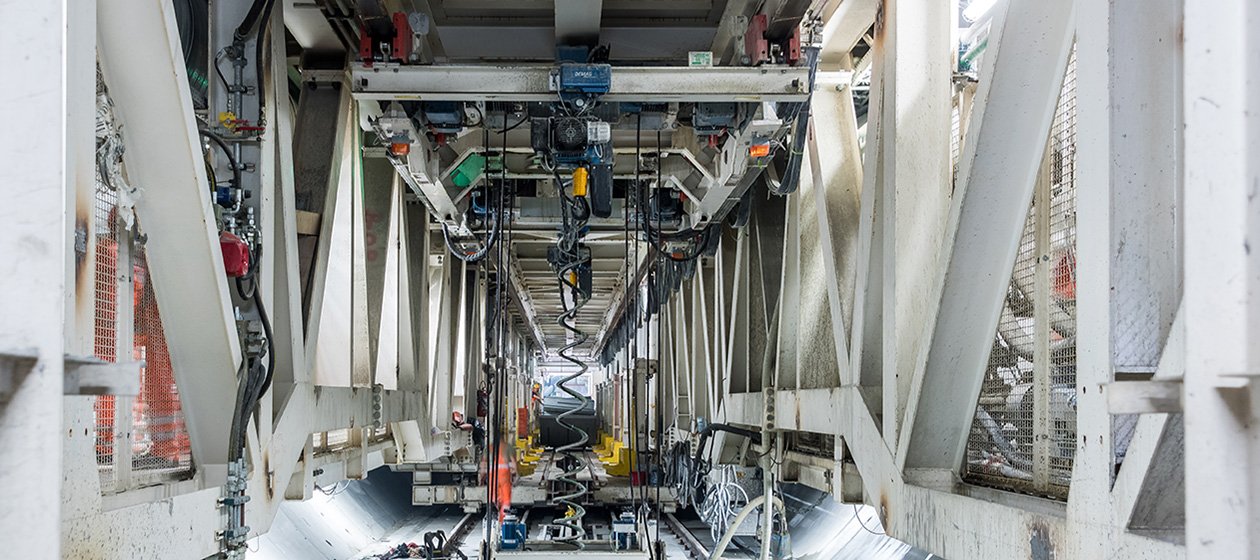
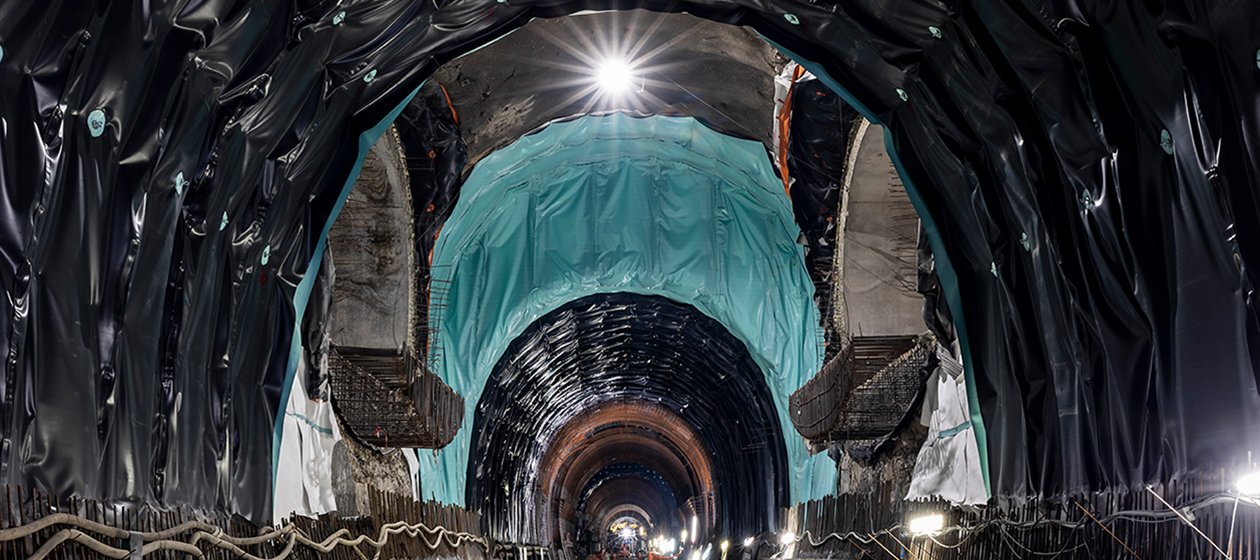
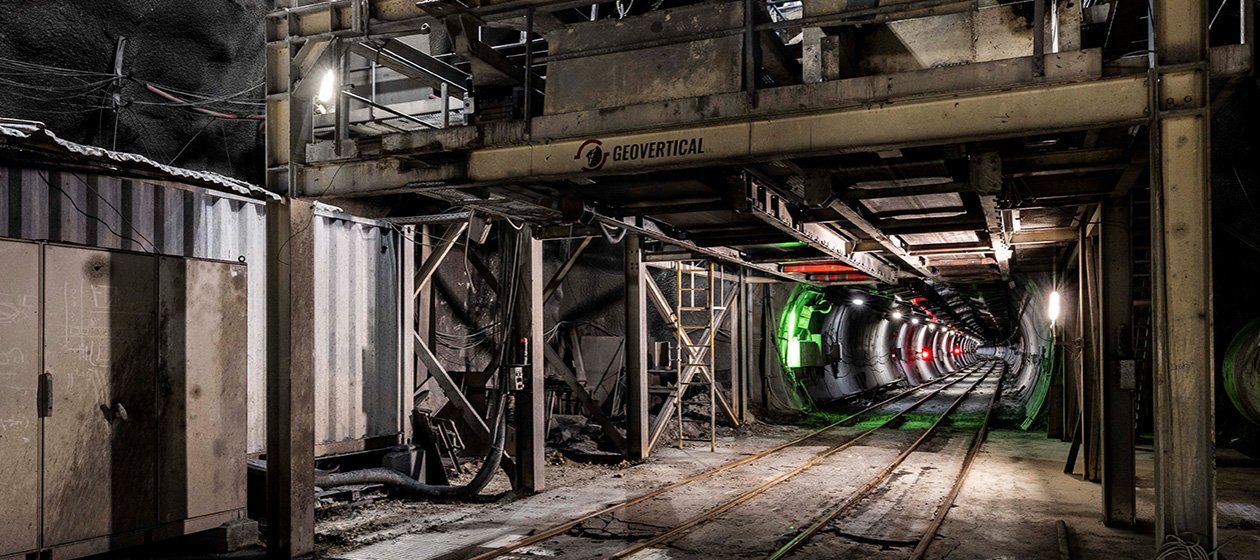
GENERAL INFORMATION ON THE CONSTRUCTION LOT
Between October 2011 and July 2015, 3.7 km of main tunnels and 1.5 km of exploratory tunnel were excavated and the so-called Periadriatic Seam was crossed, which is one of the most important fault zones along the Alpine region. Following the completion of this lot, all necessary logistical conditions were created for the following "Mules 2-3" lot.
This lot was launched in September of 2016 and is the largest construction lot of the Brenner Base Tunnel. The works in the Mules 2-3 lot, worth 993 million EUR, were awarded to the consortium including Astaldi S.p.A. (known, as of 2021, as Partecipazioni Italia S.p.A. of the Webuild S.p.A. group), Ghella S.p.A., Oberosler Cav Pietro S.r.l. (up to June of 2018), Cogeis S.p.A. and PAC S.p.A.
COMPLETED WORKS
Excavation works to connect the Mules access tunnel with the Trens emergency stop began in January 2017 and were completed in June 2020. This stretch of tunnel is 3.8 km long. Once these works were completed, the Trens emergency stop, the connections bypasses to the main tunnels and the ventilation tunnels were excavated. The final lining of the emergency stop was completed in May 2025.
On 13 March 2017, excavation work began on the main tunnels moving northwards, towards the state border. After approximately 0.8 km, excavation using drilling and blasting was completed and two double-shielded TBM started excavating.
On November 24th, 2021, after 14 km and 3.5 years of work excavating the exploratory tunnel northwards, the TBM named "Serena" reached its goal at the State border at Brenner. This was the first BBT excavation to reach the Brenner and it was a historic milestone.
The southward excavation using drilling and blasting began in April 2017 and was completed for both main tunnels in October 2020. The Mules H61 and the Isarco Underpass H71 lots were permanently joined after the breakthrough on May 19th, 2022.
On March 30th 2023, after excavating 14.2 km of the eastern tunne northwards, the tunnel boring machine named "Virginia" reached her destination. By reaching the limit of the construction lot at Brenner, "Virginia" was the first TBM in one of the main tunnels to successfully complete its work.
The TBM known as ‘Flavia’ completed the excavation of the west main tunnel on 02 May 2025, reaching the Brenner Pass. With this, all the excavation work for the main tunnels is finished.
CURRENT CONSTRUCTION WORK
ONGOING WORKS
The disassembly of the TBM is already under way and the permanent lining of the main tunnels is being installed.
The excavation and lining of the cross-connecting tunnels between the two tunnels is also ongoing.
In addition, the lining is being installed in the section of the exploratory tunnel excavated using drilling and blasting.
EXCAVATION DATA of September 29th, 2025 (Updated monthly)
| Access tunnel to the emergency stop (completed) | ||
|---|---|---|
| Excavation 3,805 m | Length 3,805 m | Cross-section 80 m² |
| Main tunnels (completed) | ||
|---|---|---|
| Excavation 39,938 m | Length 39,938 m | Cross-section 85 m² |
| Exploratory tunnel (completed) | ||
|---|---|---|
| Excavation 14,813 m | Length 14,813 m | Cross-section 35 m² |
| Crosscuts, safety- and logistics tunnels | ||
|---|---|---|
| Excavation 6,315 m | Length 6,464 m | Cross-section 26-56 m² |
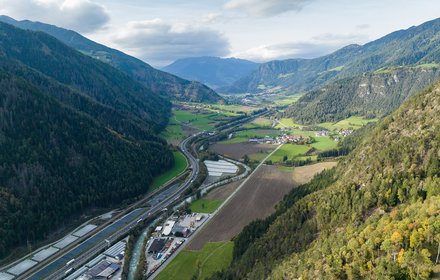
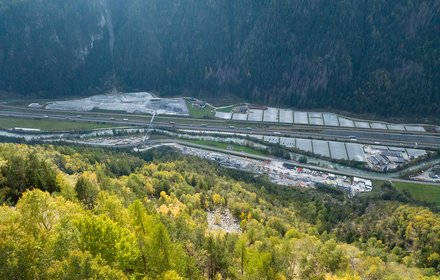
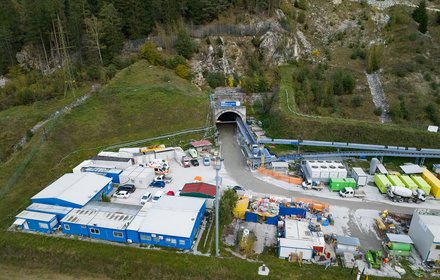
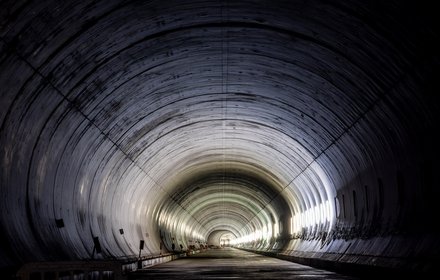
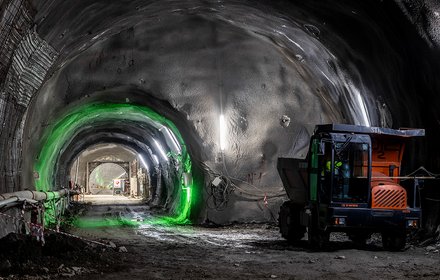
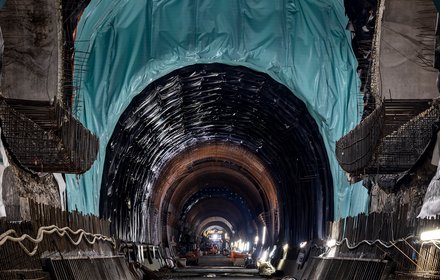
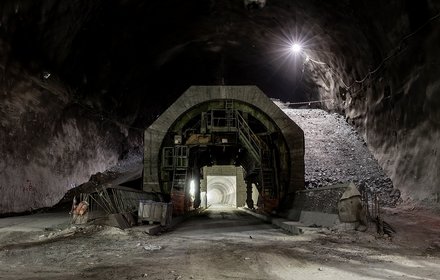
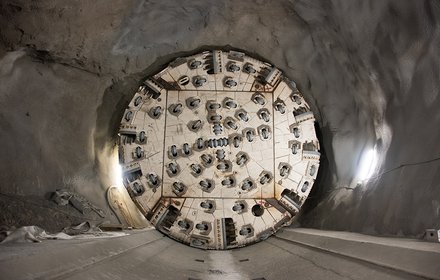
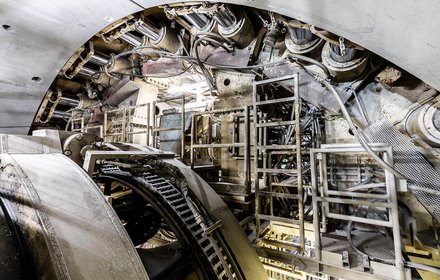
Lot H71 Isarco river underpass
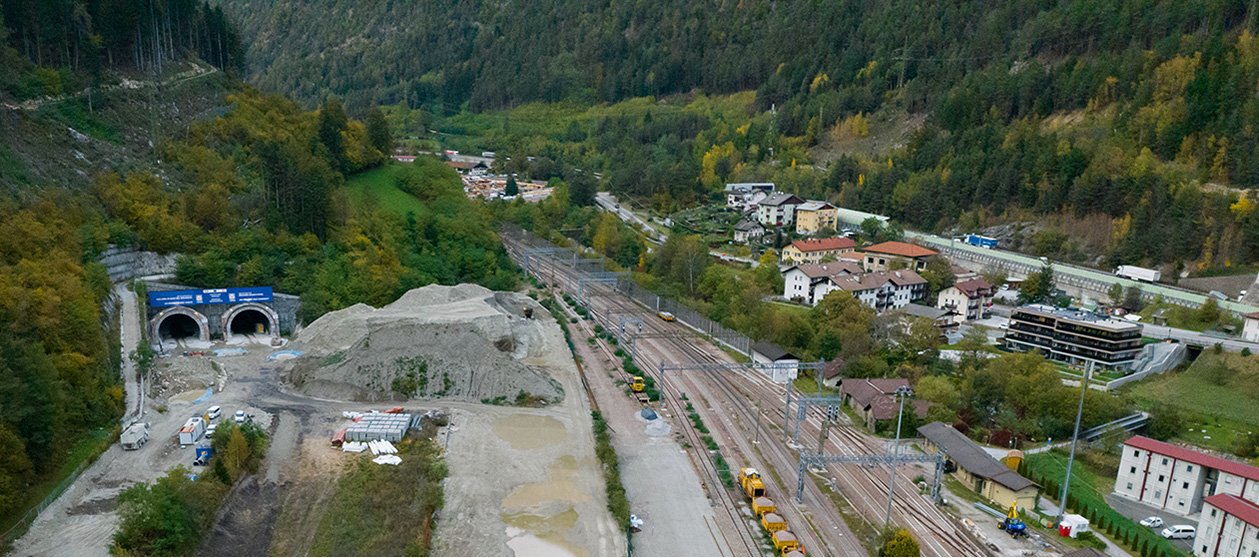
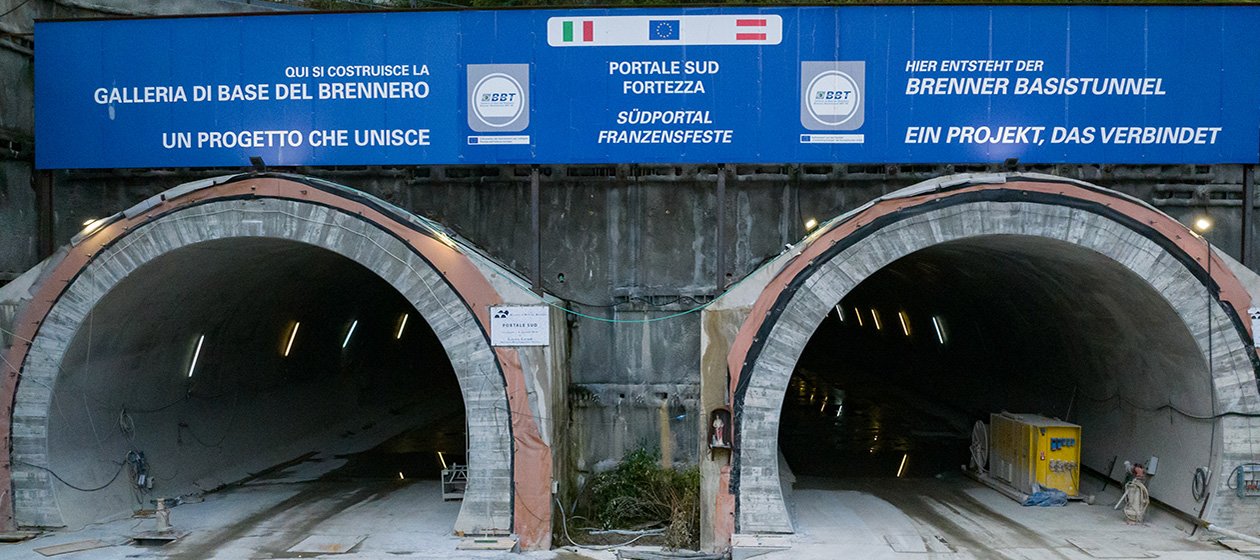
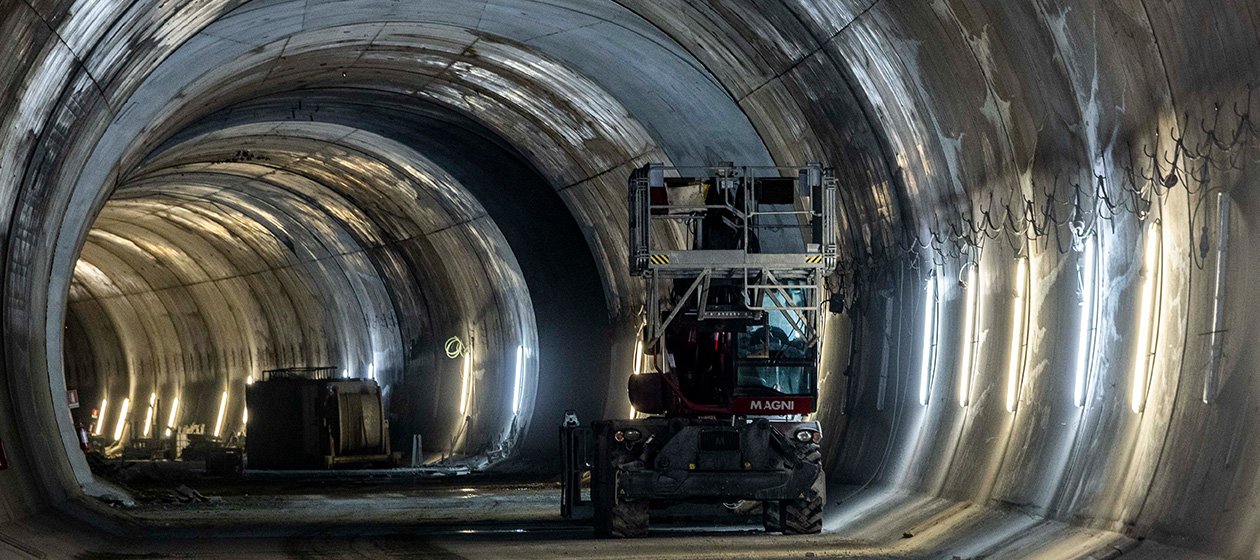
GENERAL INFORMATION ON THE CONSTRUCTION LOT
All work on this construction lot has been completed since December 2023.
The southernmost lot of the Brenner Base Tunnel, worth 301 million Euro, was awarded to the consortium Isarco s.c.a.r.l., consisting of Webuild Italia S.p.A. (formerly Salini-Impregilo), Strabag AG, Strabag S.p.A., Consorzio Integra and Collini Lavori S.p.A. in October 2014. The works of this construction lot will connect the base tunnel with the existing Brenner railway line and the Fortezza station. Overall, 4.5 km of main tunnels and 1.2 km of interconnecting tunnels to the existing railway line were built.
Most of the works in this lot on the floor of the Isarco valley and included a series of open-air works, including preliminary ground consolidation for the excavation of the tunnels along this stretch, which mainly consists of fluvioglacial non-compact sediments. These ground consolidation works were carried out using the so-called jet-grouting technique.
As part of this construction lot, tunnel stretches were excavated crossing right underneath the A22 Brenner motorway, the SS12 state road, the existing railway line and especially the Isarco river. Another special ground consolidation technique was also used to tunnel under the river: freezing.
After ground consolidation using the jet grouting technique, four shafts were excavated to a depth of approximately 20-25 metres. From these shafts, underground excavations were started northwards using D&B, drilling and blasting.
Completed construction work
By the end of 2016, as part of the so-called preparatory works, the SS12 state road had been rerouted, bridges over the Isarco river and over the Rio Bianco had been built, and an underpass of the Brenner railway line as well as a direct link with the motorway had been completed. These works opened up enough space on the valley floor to set up the construction site and carry out the construction work. In addition, the direct link to the motorway avoided the transit of vehicles through the area.
With the breakthrough with the adjacent lot on 19 May 2022, the excavation of the main tunnels in the Isarco river underpass construction lot was completed. The H61 Mules lot and the H71 Isarco river underpass, once separate construction lots, are now joined, effectively creating a single link from Fortezza almost all the way to the Brenner Pass.
On August 8th 2023, construction work on the future line tunnels in the ‘Isarco Underpass’ construction lot was completed. In eight years of work, more than 6 km of tunnels and their interior lining were constructed.
Once the landscaping work on the outer areas of the construction site is complete, all work on the southernmost lot of the Brenner Base Tunnel will have been concluded.
The aim of the 'renaturation' process, which involves the planting of more than 50000 plants, is to restore the entire area of the Isarco river underpass construction site to its original state, for the benefit of the entire population living in the vicinity of the project area.
EXCAVATION DATA - All the excavation works in this lot were completed by December 2022
| Main tunnels (completed) | ||
|---|---|---|
| Excavation 4,478 m | Length 4,478 m | Cross-section 60-150 m² |
| Connecting tunnels (completed) | ||
|---|---|---|
| Excavation 1,569 m | Length 1,569 m | Cross-section 60-80 m² |
| Connecting side tunnels, Crosscuts (completed) | ||
|---|---|---|
| Excavation 170 m | Length 170 m | Cross-section 35-45 m² |
| Shafts and access tunnel (completed) | ||
|---|---|---|
| Excavation 164 m | Length 164 m | Cross-section 65 m² |


